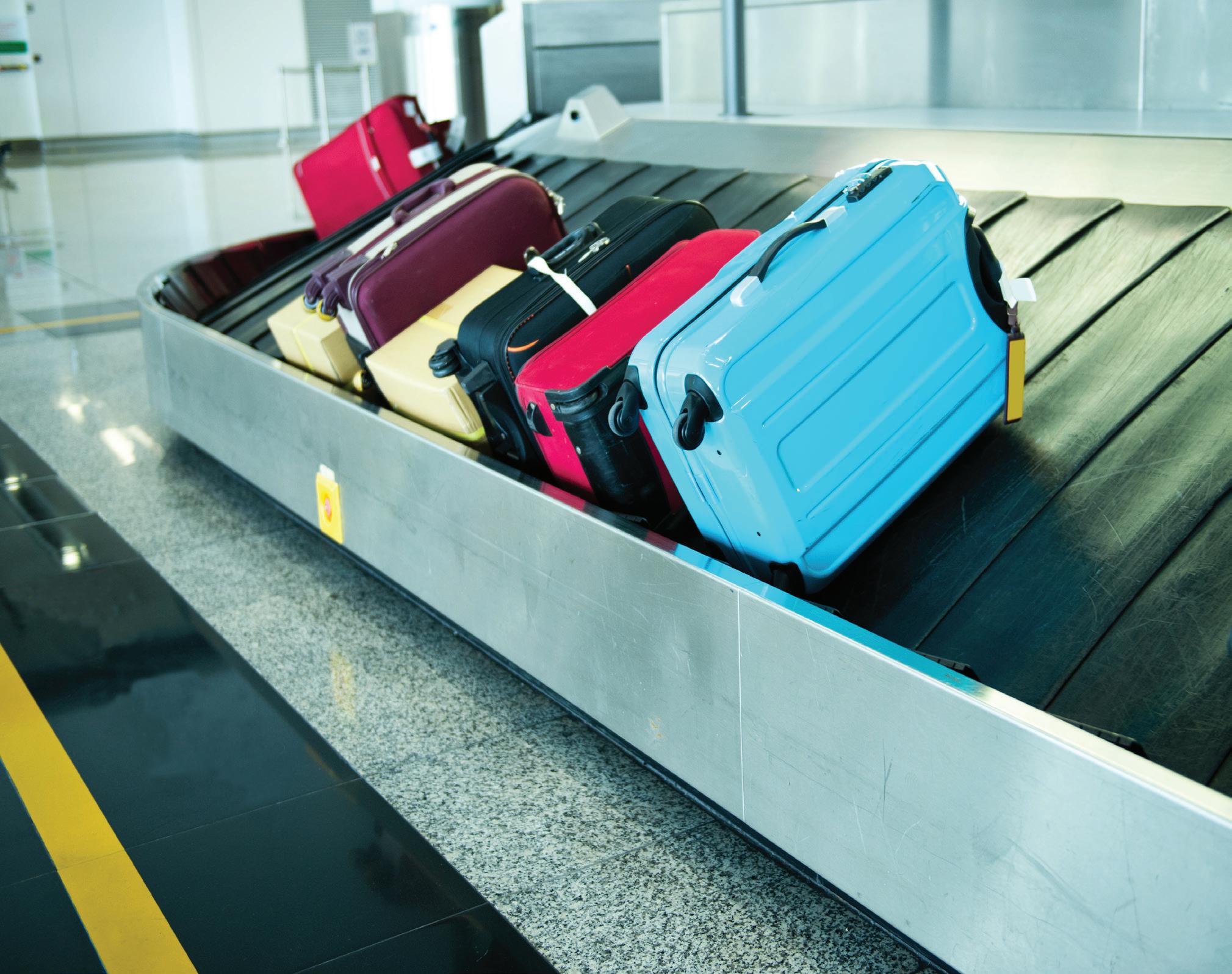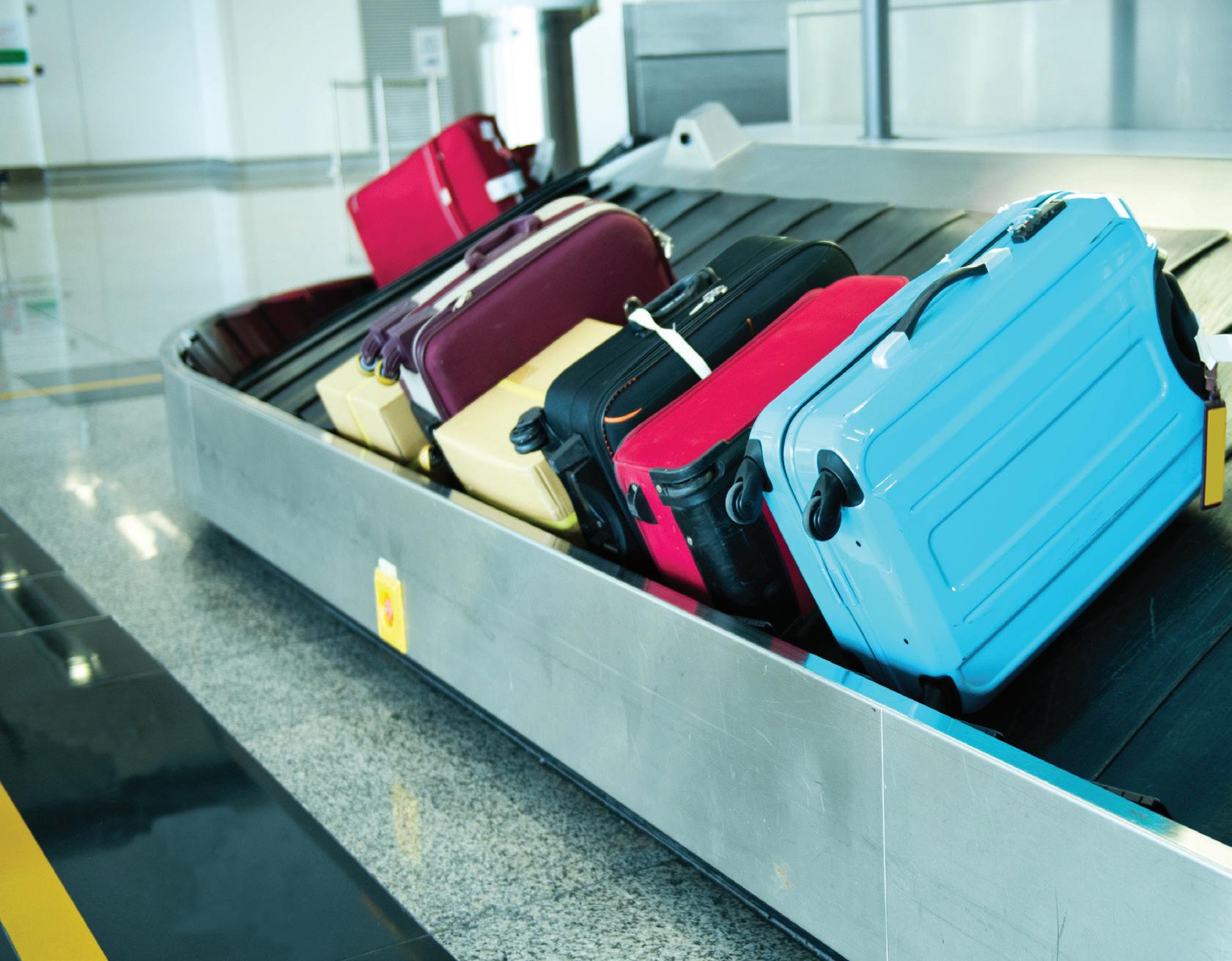


















































































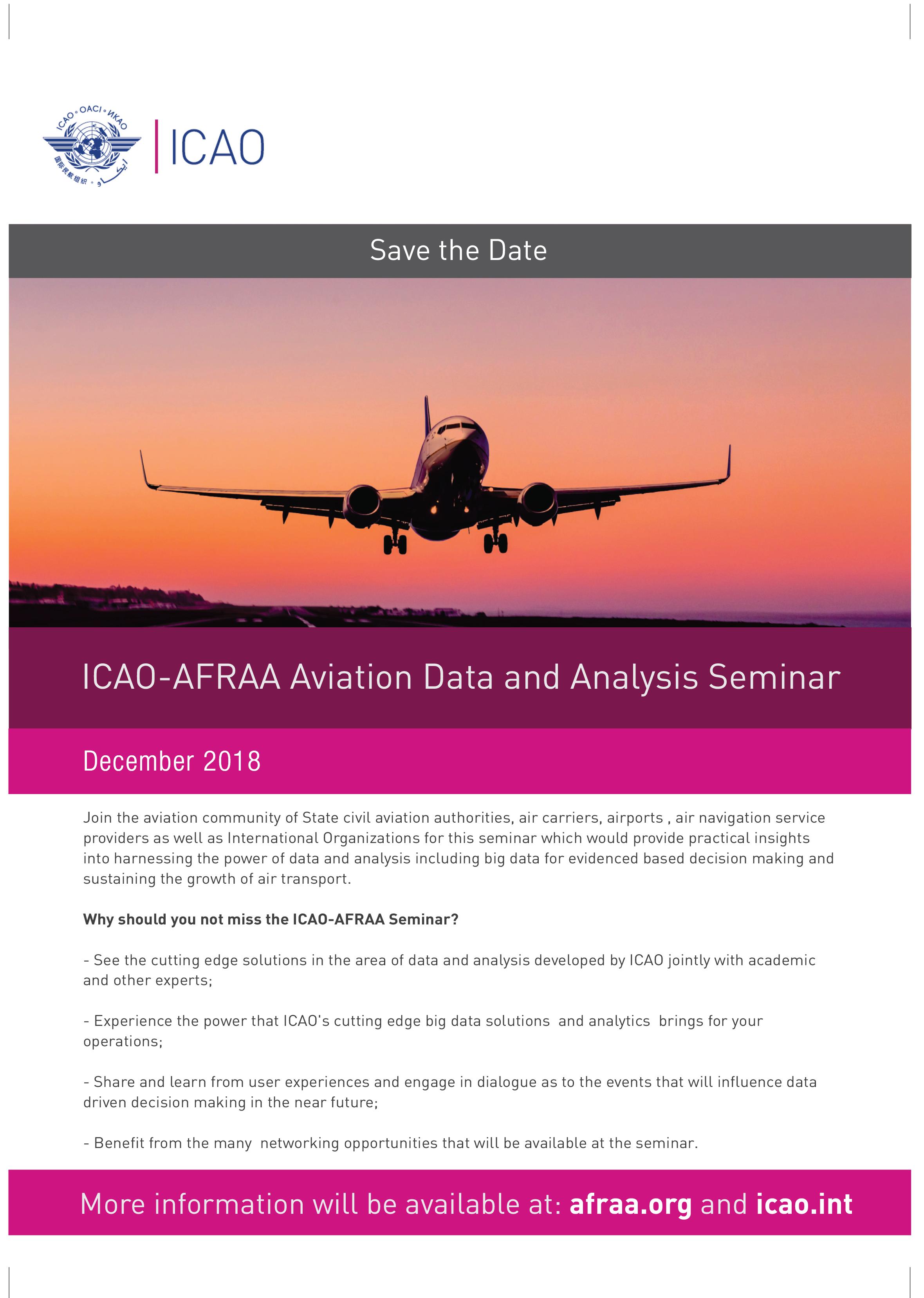

December 2018
Join the aviation community of State civil aviation authorities, air carriers, airports , air navigation service providers as well as International Organizations for this seminar which would provide practical insights into harnessing the power of data and analysis including big data for evidenced based decision making and sustaining the growth of air transport.
Why should you not miss the ICAO-AFRAA Seminar?
- See the cutting edge solutions in the area of data and analysis developed by ICAO jointly with academic and other experts;
- Experience the power that ICAO’s cutting edge big data solutions and analytics brings for your operations;
- Share and learn from user experiences and engage in dialogue as to the events that will influence data driven decision making in the near future;
- Benefit from the many networking opportunities that will be available at the seminar.
More information will be available at: afraa.org and icao.int
Global passenger tra�fic results for 2017 show a strong performance for the year. Demand in terms of revenue passenger kilometres rose by 7.6% compared to 2016 – well above IATA's 10-year average annual growth rate of 5.5%. Passenger tra�fic for African airlines in 2017 as reported by IATA, increased by 7.5% compared to 2016 while capacity rose at 3.6%. This strong performance was supported by an improvement in economic factors.

The momentum carried on in 2018 which began on a good note. Business confidence in Nigeria has been on a rise and this has been attributed to the increase in oil prices. Similarly, during the first quarter of 2018, business confidence in South Africa rose to a threeyear high following the appointment of a new Head of State. On air cargo, there has been positive freight growth from 2017 into 2018 that is attributed to supportive demand drivers such as increased trade and foreign �lows into Africa.

Even though the market outlook remains supportive in 2018, profitability for African airlines is still bleak. One of the main reasons behind this reality is limited cooperation among African airlines. It is for this reason that AFRAA in its Action Plan, launched in April this year, is focusing on encouraging airlines to forge closer commercial and technical cooperation to derive economies of scale. The Action Plan is hinged on key strategic goals which include, among others: human capital development, economics and data, world-class
Les statistiques de trafic passager mondial pour 2017 indiquent de très bonnes performances au cours de l'exercice. La demande exprimée en passagers-kilomètres transportés a progressé de 7,6% par rapport à 2016 – bien au-dessus du taux de croissance annuel moyen de 5,5% sur 10 ans estimé par IATA. Le trafic passager des compagnies aériennes africaines en 2017, selon IATA, a augmenté de 7,5% par rapport à 2016, tandis que la capacité a progressé de 3,6%. Ces excellentes performances ont été portées par une amélioration des facteurs économiques.
Cet élan s'est poursuivi en 2018, qui a démarré sur une note positive. La confiance des entreprises au Nigeria est en hausse, une évolution attribuée à l'augmentation des prix du pétrole. De même, au cours du premier trimestre de 2018, la confiance des entreprises en Afrique du Sud a atteint son plus haut niveau en trois ans après l'investiture d'un nouveau chef de l'État. Sur le front du fret aérien, une croissance positive a été enregistrée depuis 2017 et s'est poursuivie en 2018, induite par des facteurs favorables à la demande tels que l'accroissement des échanges et des �lux d'investissements étrangers en Afrique.
Même si les perspectives de marché restent favorables en 2018, la rentabilité des compagnies aériennes africaines est encore faible. Une des principales raisons derrière cette réalité est une coopération limitée entre compagnies aériennes africaines. C'est pour cette raison que l'AFRAA dans son Plan d'Action, lancé en avril dernier, s'attache à encourager les compagnies aériennes à resserrer les liens de coopération commerciale et technique, afin de réaliser des économies d'échelle. Le Plan d'Action repose sur des objectifs stratégiques clés dont, entre autres: le développement du capital humain, l'économie et les données, la sécurité de classe mondiale, un environnement aux coûts d'exploitation faibles, la libéralisation du ciel africain et la viabilité pour l'avenir grâce à de nouvelles sources de revenus. L'AFRAA lancera
safety, a low cost environment, liberalization of African skies and sustainability for the future through new revenue streams. AFRAA will also launch a number of common projects in 2018-19 aimed at lowering the cost of operations, increasing revenues and improving load factors.
Safety is a top priority for African aviation industry to thrive. Africa has seen remarkable improvements in safety in the recent years. It was reported that for 2017, airlines in the sub-Saharan region had zero jet hull losses and zero fatal accidents involving jets or turboprops for a second consecutive year. AFRAA's Action Plan encompasses initiatives to support more African airlines to get the IATA Operational Safety Audit (IOSA) and the IATA Standard Safety Assessment (ISSA). AFRAA is also dedicated to work with African governments to accelerate the implementation of ICAO's safety-related standards and recommended practices (SARPS).
As a continent and as stakeholders in the aviation industry, we must all take our human capital development responsibility seriously. Top priority must be given to the retention of the existing qualified personnel and to develop more skills in Africa to support the needs of the growing industry in the continent. Investing in the development of the human resources will improve the competitiveness of the industry and enable airlines to tap into Africa's vast potential.
Fleet renewal and the acquisition of modern aircra�t call for huge investment by African airlines and this is coupled by the associated challenge of soliciting funds from financial markets. Thus, AFRAA encourages African States that have not yet acceded to the Cape Town Convention and Protocol to do so to enhance the confidence of potential financiers and reduce the cost of financing aircra�t acquisition by airlines.
The suppliers of the various services and products are very critical for the aviation industry. Optimal performance for Africa is achievable with the support of various stakeholders. It is for this reason that AFRAA stages its annual Aviation Stakeholders Convention (ASC). This event examines the critical roles of suppliers and other stakeholders in the aviation value chain in the development of African aviation. The ASC brings together operators and service providers with the view to foster dialogue, build sustainable networks in supply chain management, create a competitive environment for business and improve the aviation business support base in the continent.
AFRAA will vigorously implement its Action plan that will transform the industry as well as help fuel positive economic progress across the African continent. The airline industry has a major transformational role to play in the area of partnerships and commercial cooperation in a globally inter-dependent business environment. If these e�forts are accompanied by support from African governments and other stakeholders, the industry's future looks optimistic.
également un certain nombre de projets communs en 2018-2019 visant à réduire le coût de l'exploitation, à augmenter les recettes et à améliorer les coe�ficients de remplissage.

La sécurité aérienne est une priorité absolue pour l'essor du secteur aéronautique africain. L'Afrique a connu des avancées remarquables en matière de sécurité aérienne ces dernières années. Il a été annoncé qu'en 2017, les compagnies aériennes de la région sub-saharienne ont enregistré zéro perte de coque d'avion à réaction et zéro accident mortel impliquant des jets ou turbopropulseurs pour la deuxième année consécutive. Le Plan d'Action de l'AFRAA comprend des initiatives visant à accompagner davantage de compagnies aériennes africaines pour qu'elles puissent passer l'Audit de sécurité de l'exploitation de l'IATA (IOSA) et l'Évaluation de sécurité standard de l'IATA (ISSA). L'AFRAA tient également à œuvrer avec les gouvernements africains à l'accélération de la mise en œuvre des normes et pratiques recommandées de l'OACI (SARP) relatives à la sécurité.
Tout le continent et l'ensemble des parties prenantes de l'industrie aéronautique, devons prendre au sérieux notre responsabilité en matière de développement du capital humain. La priorité absolue doit être de retenir le personnel qualifié actuel et de développer davantage de compétences en Afrique pour répondre aux besoins d'une industrie africaine en pleine croissance. Investir dans le développement des ressources humaines améliorera la compétitivité du secteur et permettra aux compagnies aériennes d'exploiter le vaste potentiel de l'Afrique.
Le renouvellement de la �lotte et l'acquisition d'avions modernes nécessitent d'énormes investissements devant être consentis par des compagnies africaines et cela s'accompagne du défi de lever des fonds sur les marchés financiers. Pour ce faire, l'AFRAA encourage les États africains qui n'ont pas encore adhéré à la Convention du Cap et au Protocole aéronautique de le faire pour renforcer la confiance des financiers potentiels et réduire le coût de financer l'acquisition d'avions par les compagnies aériennes.
Une industrie aéronautique prospère suppose des prestataires de di�férents services et produits qui sont des acteurs essentiels. L'Afrique est capable de réaliser des performances optimales avec le soutien de divers intervenants. C'est pour cette raison que l'AFRAA organise la Convention annuelle des acteurs de l'aviation (ASC). Cette manifestation constitue un forum pour examiner les rôles essentiels des fournisseurs et d'autres parties prenantes tout au long de la chaîne de valeur du transport aérien, dans le développement de l'aviation africaine. L'ASC est une initiative de l'AFRAA visant à rassembler les transporteurs et les prestataires de services en vue de favoriser le dialogue, de créer des réseaux durables dans la gestion de la chaîne d'approvisionnement, de mettre en place un environnement concurrentiel pour les entreprises et de renforcer le soutien à l'activité aéronautique en Afrique.
L'AFRAA mettra en œuvre énergiquement son Plan d'Action qui a vocation à transformer l'industrie et à contribuer au progrès économique positif de l'ensemble du continent africain. Le secteur du transport aérien a un rôle transformateur majeur à jouer à travers des partenariats et la coopération commerciale dans un environnement d'a�faires interdépendant. Si ces e�forts sont accompagnés par le soutien des gouvernements africains et d'autres acteurs, l'avenir de l'industrie s'annonce prometteur.
Mr. Abdérahmane Berthé AFRAA Secretary General Secrétaire Général AFRAAMay – July 2018
11
Bonne nouvelle à propos des bagages des passagers aériens
This is the 14th year that SITA has issued its report and it marks 2018 as a turning point for the global air transport industry as airlines increasingly adopt baggage tracking technologies.
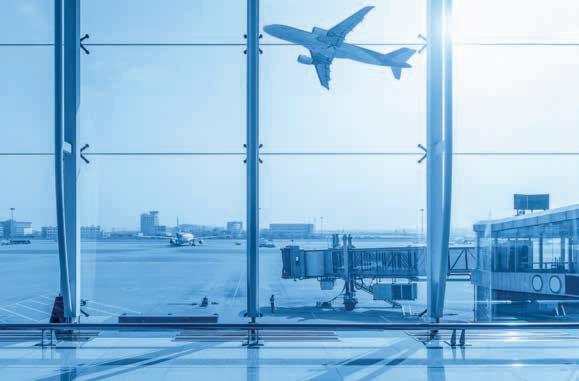
Cette 14ème édition annuelle du rapport de SITA fait de 2018 un point tournant pour l'industrie du transport aérien mondial au moment où les compagnies aériennes embrassent de plus en plus les technologies de suivi des bagages.
14
The digital airline
La compagnie aérienne digitale
Airlines need to gain traction from a digital perspective to keep pace with today’s savvy air travellers.
Les compagnies aériennes doivent accélérer leur transformation digitale pour tenir la cadence des voyageurs aériens actuels qui maitrisent bien les technologies.
22
Rolls-Royce: A year in re�lection

Rolls-Royce has defined a vision for the future of aircra�t power that will help deliver travellers more reliably and more e�ficiently than ever before.
26
What do passengers value most about airline travel?
For airline customers, this is the sweet spot where they feel the balance between product, service and convenience is achieved. Each time a customer searches for a �light, they bring their individual values to the search.
28
Driving African airline success in 2018
This is an exciting time for airlines across Africa, and our goal is to make travel easier for all carriers – and for their passengers – with the most efficient mobile booking, ticketing and payment solutions.
31
Embraer Airline Business Seminar, Johannesburg
Great delegates and excellent opportunities to network were among the highlights of this successful event.
PUBLISHERS | EDITEUR
Camerapix Publishers International Limited
EDITORIAL DIRECTOR | DIRECTEUR DE LA RÉDACTION
Rukhsana Haq
MANAGING EDITOR | RÉDACTEUR EN CHEF
Maureen Kahonge
COPY EDITOR | RÉVISEUR
Cecilia Gaitho
SENIOR DESIGNER | CONCEPTEUR PRINCIPAL
Sam Kimani
DESIGNER | CONCEPTEUR
Steve Gichau
PRODUCTION MANAGER | GÉRANTE DE PRODUCTION


Rachel Musyoni
FRENCH TRANSLATION | TRADUCTION FRANÇAISE
Ephrem Kamanzi
ADMINISTRATION | ADVERTISING | PUBLICITÉ

Azra Chaudhry (UK)
Rose Judha (Kenya)
Message from AFRAA’s Secretary General
Message du Secrétaire Général de l’AFRAA
32
Aircra�t analysis: Airbus A330
Analyse d'avions: Airbus A330
The A330 has become a popular addition to many global airline �leets including those in Africa.
A330 s'est avéré très apprécié dans plusieurs �lottes de compagnies aériennes à travers le monde, y compris celles d'Afrique.
35
Journal de l'AFRAA
Welcome to AFRAA's communiqué. Découvrez les dernières nouvelles de l'AFRAA.
01 47

News update
Les brèves
Here is the top news on various airlines in the region. Actualités des compagnies aériennes de la région.

Africa Wings is published quarterly for AFRAA by Camerapix Magazines Limited Africa Wings est publié trimestriellement par Camerapix Magazines Limited pour le compte de l'AFRAA
Correspondence on editorial and advertising matters may be sent to either of these addresses
Toute correspondance relativeà la rédaction et aux annonces peut être envoyée à l'une des adresses suivantes:
Editorial and Advertising O�fices: Camerapix Magazines Limited PO Box 45048, 00100, GPO Nairobi, Kenya
Tel: +254 (20) 4448923/4/5
Fax: +254 (20) 4448818 or 4441021
Email: creative@camerapix.co.ke
Camerapix Magazines (UK) Limited
32 Friars Walk, Southgate, London, N14 5LP
Tel: +44 (20) 8361 2942
Mobile: +447756340730
Email: camerapixuk@btinternet.com
afraa@afraa.org
Printed in Nairobi, Kenya
Imprimé à Nairobi, Kenya
© 2018 CAMERAPIX MAGAZINES LTD
All rights reserved. No part of this magazine may be reproduced by any means without permission in writing from AFRAA. While every care is taken to ensure accuracy in preparing Africa Wings, the publishers and AFRAA take no responsibility for any errors or omissions contained in this publication.
Tous droits réservés. Aucune parrtie de ce magazine ne peut être reproduite sans la permission écrite de l'éditeur. Bien que toutes les précautions aient été prises pour garantir l'exactitude des informations au cours de la préparation de Ailes d’ Afrique, les éditeurs et AFRAA n'assument aucune responsabilité pour les erreurs ou omissions contenues dans cette publication.
Africa Wings is also available online www.afraa.org






Singapore Changi Airport set a new record of 62.2 million total passenger movements in 2017. This is a 6% growth from the previous year.
In 2017, traffic across all regions saw positive growth, with Southeast and Northeast Asia contributing to about 70% of total traffic. Among Changi Airport’s top 10 country markets, China and India led with a robust double-digit growth of 12% and 16%, respectively. With the return of Ethiopian Airline’s new service between Addis Ababa and Singapore as well as the addition of the fourth frequency between Mauritius and Singapore via Air Mauritius, passenger movements for Africa increased significantly by 20%.
During the year, Changi Airport also welcomed three passenger airlines – Hebei Airlines, Norwegian and US-Bangla Airlines, to its family of over 100 airlines. Ten new passenger city links were also established, to China (Harbin, Shijiazhuang, Yantai), Greece (Athens), India (Madurai), Japan (Hiroshima, Okinawa), Malaysia (Bintulu), Sweden (Stockholm) and USA (Honolulu). Airfreight throughput also grew by 7.9%, crossing the 2-million tonne mark for the first time to reach 2.13
L’aéroport Changi de Singapour a atteint un nouveau record, soit 62,2 millions de mouvements de passagers en 2017. Cela représente une progression de 6% par rapport à l’année précédente.
En 2017, le trafic pour toutes les régions a enregistré une croissance positive, l’Asie du sud-est et l’Asie du nord-est représentant environ 70% du trafic total. Parmi les 10 premiers marchés de pays pour l’aéroport Changi, la Chine et l’Inde étaient en tête avec une croissance robuste à deux chiffres de 12% et 16%, respectivement. Avec le retour du nouveau service de la compagnie Ethiopian Airlines entre Addis-Abeba et Singapour ainsi que l’ajout de la quatrième fréquence d’Air Mauritius entre Maurice et Singapour, les mouvements de passagers pour l’Afrique ont progressé de 20%.
Au cours de l’année, Changi a également accueilli trois transporteurs de passagers, à savoir: Hebei Airlines, Norwegian et US-Bangla Airlines, au sein de sa famille de plus de 100 compagnies aériennes. Dix nouvelles liaisons aériennes pour passagers ont été également établies, vers la Chine (Harbin, Shijiazhuang, Yantai), la Grèce (Athènes), l’Inde (Madurai), le Japon (Hiroshima, Okinawa), la Malaisie (Bintulu), la Suède (Stockholm) et les États-Unis (Honolulu).
Le volume de fret aérien a également augmenté de 7,9%, dépassant pour la première fois la barre des 2 millions
Un nombre record de 62,2 millions de passagers accueillis par l’aéroport Changi en 2017
million tonnes for the year. Growth was observed for airfreight throughput across imports (+8%), exports (+14%) and transshipments (+4%). The top five country markets for airfreight were China, Australia, Hong Kong, the United States and India.
Changi Airport formalised the Pharma@Changi initiative in October 2017, together with nine other partners from across each node of the supply chain. Under this initiative, the companies will jointly pursue the best standards in pharmaceuticals handling, and will promote Singapore Changi Airport as a trusted and reliable pharmaceuticals air cargo hub in the region. Earlier in the year, Changi Airport also became the first airport community in Asia Pacific to attain the IATA CEIV Pharma certification. Changi Airport’s cargo capabilities has also been enhanced with the opening of SATS’ new eCommerce Airhub, to improve eCommerce mail sorting capability to support the growing eCommerce market with its state-of-the-art automated airside eCommerce mail sortation facility, further boosting the airport’s position as a leading air cargo hub in Asia.
de tonnes pour atteindre 2,13 millions de tonnes pour l’année. La croissance du volume de fret aérien a été observée pour les importations (+8%), les exportations (+14%) et les transbordements (+4%). Les principaux cinq marchés du fret aérien étaient la Chine, l’Australie, Hong Kong, les États-Unis et l’Inde.
L’aéroport Changi a formalisé l’initiative Pharma@ Changi en octobre 2017, en collaboration avec neuf autres partenaires à chaque maillon de la chaîne d’approvisionnement. Dans le cadre de cette initiative, les sociétés mettront en œuvre conjointement les meilleures normes applicables à la manutention des produits pharmaceutiques, et assureront la promotion de l’aéroport Changi de Singapour comme un hub pour le fret aérien de produits pharmaceutiques fiable de la région. Au début de l’année, Changi est également devenu la première communauté aéroportuaire en Asie-Pacifique à obtenir la certification IATA CEIV Pharma. Les capacités de fret de l’aéroport Changi ont également été augmentées suite à l’ouverture du nouveau eCommerce Airhub de SATS, pour améliorer la capacité de soutenir le marché croissant d’eCommerce grâce à une installation ultra-moderne de tri automatisé du courrier d’eCommerce côté piste, afin de renforcer davantage le positionnement de l’aéroport en tant que plaque tournante leader pour le fret aérien en Asie.
Left: Members of Pharma@Changi (L-R): Bolloré Logistics, CEVA Logistics Singapore, Changi Airport Group, DHL Global Forwarding, dnata
Singapore, Expeditors
Singapore, Global Airfreight International, SATS, Schenker Singapore and Singapore Airlines Cargo.
La gauche: Membres de Pharma@Changi (L-R): Bolloré Logistics, CEVA Logistics

Singapore, Changi Airport Group, DHL Global Forwarding, dnata
Singapore, Expeditors
Singapore, Global Airfreight International, SATS, Schenker
Singapore et Singapore Airlines Cargo.
Changi Airport clinched a total of 26 Best Airport awards in 2017, including Business Traveller UK’s ‘Best Airport in the World’ award for the 30th consecutive year. Changi Airport also received 2018 World’s Best Airport by Skytrax World Airport Awards for the sixth consecutive time. With the completion
L’aéroport Changi a décroché un total de 26 prix Best Airport en 2017, y compris le prix «Meilleur aéroport du monde» de Business Traveller UK pour la 30ème année consécutive. Il a également gagné le prix «Meilleur aéroport du monde» édition 2018 de Skytrax World Airport Awards pour la sixième année consécutive.
and opening of the newest tech-friendly Terminal 4, Changi Airport welcomes a brand new travel experience with Terminal 4’s boutique design and innovative use of technology to automate processes. Eleven airlines currently operate in Terminal 4 –the AirAsia Group (of four airlines), Cathay Pacific, Cebu Pacific, Korean Airlines, Spring Airlines, JC International, Vietjet and Vietnam Airlines.
In 2018, Changi Airport expects more development in the long-haul segments to Europe, including Scoot’s non-stop service to Berlin, and LOT Polish Airlines’ new service connecting Singapore and Warsaw. Qantas’ Singapore-London route has also returned to Changi Airport with an overall increase in seat capacity between Singapore and Australia. Changi Airport will also continue to improve connectivity to secondary cities of China and India. 2018 also marks the 50th anniversary of AfricaSingapore business relations, where Changi Airport will also look forward to further strengthen traffic between Africa and Singapore.
A la suite de l’achèvement et de l’ouverture du nouveau Terminal 4 de convivialité technologique, l’aéroport Changi propose une toute nouvelle expérience de voyage avec le nouveau design des boutiques et l’utilisation des technologies au Terminal 4 pour automatiser les processus. Onze compagnies aériennes desservent actuellement le Terminal 4 – AirAsia Group (de quatre compagnies aériennes), Cathay Pacific, Cebu Pacific, Korean Airlines, Spring Airlines, JC International, Vietjet et Vietnam Airlines.
En 2018, l’aéroport Changi attend des nouveautés dans les segments long-courriers vers l’Europe, dont les vols non-stop de Scoot sur Berlin et la nouvelle desserte de LOT Polish Airlines reliant Singapour et Varsovie. La liaison Singapour-Londres assurée par Qantas est également retournée à l’aéroport Changi avec une augmentation globale du nombre de sièges offerts entre Singapour et l’Australie. Changi continuera également à améliorer la connectivité vers des villes secondaires de Chine et de l’Inde. 2018 marque également le 50ème anniversaire des relations commerciales entre l’Afrique et Singapour. L’aéroport Changi entend renforcer davantage le trafic entre l’Afrique et Singapour.
Airport will enhance
overall passenger experience with its myriad range of lifestyle offerings. La gauche: La nouvelle icône de l’aéroport Changi. Le complexe Jewel à l’aéroport Changi permettra d’améliorer l’expérience globale du passager grâce à sa panoplie d’offres de mode de vie.
In 2019, visitors to
can look forward to a refreshing line up of unique lifestyle offerings at Changi’s newest development – Jewel Changi Airport
 Left: The new icon of Changi Airport. Jewel Changi
the
Photo credit: Jewel Changi Airport Devt.
Singapore
En 2019, les visiteurs de Singapour peuvent s’attendre à une rafraîchissante gamme d’offres de style de vie uniques dans le plus récent complexe de Changi –
Left: The new icon of Changi Airport. Jewel Changi
the
Photo credit: Jewel Changi Airport Devt.
Singapore
En 2019, les visiteurs de Singapour peuvent s’attendre à une rafraîchissante gamme d’offres de style de vie uniques dans le plus récent complexe de Changi –
(Jewel), a world-class lifestyle destination located in the heart of the airport.
Designed by world-renowned architect Moshe Safdie, Jewel will allow visitors to immerse in the wonders of nature under all weather conditions within Jewel’s iconic glass-and-steel façade. Be wowed by the magnificent Forest Valley, a five-storey lush garden made up of thousands of trees, palms and shrubs, and the majestic 40 metres-high Rain Vortex, set to be the world’s tallest indoor waterfall. Jewel is also home to world-class play attractions at the Canopy Park, located at the topmost level of the complex. Canopy Park will also have gardens and all-day dining options, offering a gamut of sensory experiences for the young and the young-at-heart.
Jewel Changi Airport (Jewel), une destination style de vie de classe mondiale située en plein cœur de l’aéroport. Conçu par le célèbre architecte Moshe Safdie, Jewel permettra aux visiteurs de plonger dans les merveilles de la nature, quelles que soient les conditions météo, au sein de la façade de verre et d’acier emblématique du complexe. Laissez-vous séduire par la magnifique Vallée de la forêt, un jardin luxuriant de cinq étages, composé de milliers d’arbres, de palmiers et d’arbustes et par le majestueux Rain Vortex de 40 mètres de hauteur, qui sera la plus haute cascade d’intérieur du monde. Jewel abrite également des attractions ludiques de classe mondiale au Canopy Park, situé au dernier étage du complexe. Canopy Park proposera également des jardins et des options de restauration toute la journée, offrant une gamme d’expériences sensorielles pour les jeunes et les moins jeunes.

Left: Breathtaking Forest Valley, a lush environment filled with thousands of trees, plants, ferns and shrubs, for visitors to immerse themselves in a green valley of verdant landscaping and waterfalls.
La gauche: L’époustouflante Forest Valley, un environnement luxuriant rempli de milliers d’arbres, de plantes, de fougères et d’arbustes, permettant aux visiteurs de se plonger dans une verte vallée d’un paysage verdoyant et de chutes d’eau.
Jewel also promises to be a retail wonderland where 300 retail and dining establishments from international flagship stores and homegrown Singaporean brands will turn shopping trips into journeys of discovery. A 130-room cabin hotel by YOTELAIR as well as aviation facilities that include tax refund, early check-in, left luggage services, and a dedicated lounge that offers baggage transfer and shuttle services for fly-cruise, fly-ferry and fly-coach passengers, are all conveniently located within Jewel.
Jewel promet d’être un pays des merveilles de détail où 300 boutiques et restaurants, aussi bien des marques internationales que singapouriennes, changeront les voyages de shopping en voyages de découverte. Un hôtel de 130 chambres de YOTELAIR ainsi que des installations aéronautiques dont le remboursement de taxes, un check-in à l’avance, les services de consigne et un salon dédié qui offre des services de transfert de bagages et de navette, pour les passagers qui veulent prendre le bateau, le ferry ou le bus, sont tous idéalement situés dans le complexe Jewel.




En tant que premier centre nancier et commercial de l'A sie, nous abritons un réseau en pleine expansion qui vous relie à 120 destinations en A sie - Paci que et 40 0 villes à travers le monde. Qui plus est, vous êtes en droit d'at tendre des transits uides et un ser vice exceptionnel de la par t de l'aérop or t le plus primé au monde, qui vous o re le tremplin dont vous avez besoin p our prosp érer sur le marché en plein essor d'A sie - Paci que.
Repensez le voyage. Pour explorer des opp or tunités commerciales visiter changiairport.com/airhub

GENEVA – 19 April 2018 – Airlines around the world have once again improved the rate of baggage delivery, this is according to the SITA 2018 Baggage Report published in April 2018. This continues the improvement trend of more than a decade which has seen baggage mishandling drop by 70% since 2007. This is the 14th year that SITA has issued its report and it marks 2018 as a turning point for the global air transport industry as airlines increasingly adopt baggage tracking technologies.
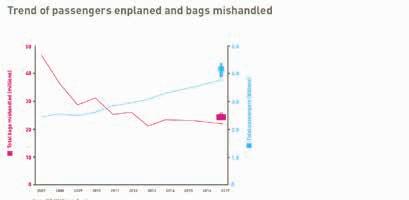
SITA's report details how baggage management is changing globally and airline passengers can expect to see major di�ferences over the next two years. Services like real-time notifications and fast selfservice bag drop will be more commonplace and 2018 is the year that the International Air Transport Association (IATA) Resolution 753 comes into e�fect which will see the industry increase baggage tracking.
Barbara Dalibard, CEO, SITA, said: “Over the last decade, we have seen significant improvements in bag management as airlines have taken advantage of technology. Now with IATA's drive for 100% bag tracking, technology adoption will rise further. End-to-end tracking produces data which reveals where improvements can be made in operational processes. While we won't see a sudden change in 2018, it is a real turning point for the industry as airlines begin to unlock the value of the tracking data for the 4.65 billion bags they carry.”
GENEVE – 19 avril 2018 – Les compagnies aériennes du monde entier ont une fois de plus amélioré leur taux de livraison des bagages, selon le rapport de SITA sur la gestion des bagages, publié en avril 2018. C'est en e�fet une amélioration de la tendance initiée il y a une décennie qui a vu le nombre de bagages mal gérés chuter de 70% depuis 2007. Cette 14ème édition annuelle du rapport de SITA fait de 2018 un point tournant pour l'industrie du transport aérien mondial au moment où les compagnies aériennes embrassent de plus en plus les technologies de suivi des bagages.
Ce rapport explique l'évolution de gestion des bagages à l'échelle mondiale et informent les passagers qu'ils peuvent s'attendre à vivre une expérience nettement meilleure au cours des deux prochaines années. Des services tels que les notifications en temps réel et l'enregistrement rapide des bagages en self-service devraient rapidement se généraliser En parallèle, l'entrée en vigueur cette année de la Résolution 753 de l'International Air Transport Association (IATA) devrait accélérer le développement des services de suivi des bagages.

Barbara Dalibard, PDG de SITA, souligne: «Au cours des dix dernières années, les compagnies se sont appuyées sur les nouvelles technologies pour proposer de meilleures prestations dans la gestion des bagages. En s'engageant pour un tracking systématique des bagages, l'IATA va accélérer les déploiements technologiques de bout en bout et permettre de mieux comprendre les points d'amélioration. Cela devrait prendre plus d'une année, mais il est clair que 2018 est une année charnière, une année au cours de laquelle les compagnies aériennes vont commencer à libérer la valeur des données liées au tracking de plus de 4,65 milliards de bagages transportés à travers le monde.»
La croissance du nombre de passagers à l'échelle mondiale exerce une pression considérable sur les systèmes et processus de gestion des bagages du secteur aérien. Les compagnies aériennes ont transporté plus de 4 milliards de passagers en 2017, mais elles ont réussi à réduire le nombre de bagages mal gérés. En e�fet, le taux record de 5,57 valises mal gérées pour 1.000 passagers a été le plus bas niveau jamais enregistré. Malgré cette amélioration, le coût de ces problèmes reste élevé puisqu'il était estimé à 2,3 milliards de dollars en 2017. Ainsi donc, les transporteurs ont encore d'énormes possibilités de réaliser des économies en investissant dans le système de tracking de bagages de bout en bout.
Le rapport de SITA sur la gestion des bagages revient sur un certain nombre de déploiements technologiques mis en œuvre par certains transporteurs comme Aero�lot, Alitalia, Bahamasair, Delta et Qatar pour améliorer
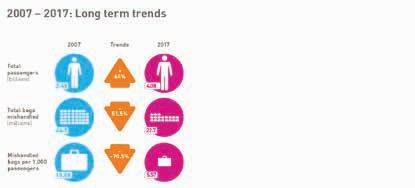
The growth in passenger numbers globally puts considerable pressure on the industry's baggage systems and processes. With the rise to more than 4 billion passengers in 2017, the airlines did well to reduce the rate of mishandled bags. In fact, at 5.57 per thousand passengers it was the lowest level ever recorded. Despite the improvement, mishandled bags cost the industry an estimated $2.3 billion in 2017 so there is considerable scope for cost savings from airline investments in end-to-end bag tracking.

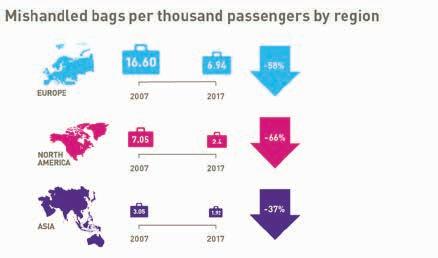
SITA's Baggage Report includes examples of how airlines, including Aero�lot, Alitalia, Bahamasair, Delta and Qatar, are using innovative and proven technologies to improve bag management and tracking. One case study outlines how the airline Bahamasair went from scanning bag tag labels on a ‘bingo’ card to full Resolution 753 tracking in Miami and Nassau airports inside seven days. This included the full ability to share tracking data in real-time via SITA's BagJourney service. This initiative will deliver benefits to the airline in the way of improved passenger service and cost savings.
SITA provides IT and communications to the air transport industry and is the only single-source vendor covering all areas of baggage management from data capture to management and sharing using the latest technology. SITA has been the recognised leader in bag tracking and tracing for more than 25 years with its systems in every major airport in the world. SITA BagJourney is the world's first community-based baggage tracking system that provides an end-toend view of the baggage journey using data from multiple sources. Today, SITA is leading the baggage community by providing technology and professional services to help airlines track baggage and unlock the value of the vast amounts of tracking data that will be produced.
la gestion et le tracking des sacs. Une étude de cas montre comment dans les aéroports de Miami et de Nassau, Bahamasair a remplacé en sept jours le scan des étiquettes de bagages via cartes «bingo» par un tracking complet selon les normes de la Résolution 753. Les données sont partagées en temps réel via le service BagJourney de SITA. Grâce à cette initiative, la compagnie des Bahamas sera en mesure de proposer une meilleure qualité de service à ses passagers tout en réduisant ses coûts.
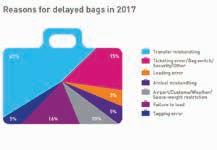

SITA fournit des solutions technologiques à l'industrie du transport aérien et elle est le seul fournisseur complet couvrant toutes les facettes de la gestion des bagages depuis la saisie jusqu'au partage des données en s'appuyant sur les technologies les plus récentes. SITA est le leader reconnu dans le suivi et le repérage des bagages depuis plus de 25 ans grâce à ses systèmes installés dans tous les grands aéroports du monde. SITA BagJourney est le premier système communautaire de suivi des bagages qui donne une vue du cheminement des bagages de bout en bout en utilisant des données de sources multiples. Aujourd'hui, SITA est le leader dans le domaine des bagages et fournit des technologies et des services professionnels pour aider les transporteurs aériens à assurer le suivi des bagages et libérer la valeur des vastes quantités de données liées au tracking qui seront produites.
SITA has been the recognised leader in bag tracking and tracing for more than 25 years with its systems in every major airport in the world.
SITA est le leader reconnu dans le suivi et le repérage des bagages depuis plus de 25 ans grâce à ses systèmes installés dans tous les grands aéroports du monde

AGS is Africa’s professional and quality one-stop resource for all your aviation needs: commercial aircraft spare parts, initial parts provisioning, mechanicals, avionics, wheel and brakes, MRO services, GSE, training, and warehouse design. All backed by attractive financing and service reps who speak your language.





The airline industry has changed significantly during the last several decades. More than 1.2 billion tourists travelled abroad in 2016, an increase of 46 million tourists during the previous year (and a staggering increase of about 1 billion travellers annually since 1950). The year 2016 represents the seventh consecutive year of sustained growth and is the longest sequence of uninterrupted growth for the aviation industry since the 1960s, according to The United Nations World Tourism Organisation. While this growth is certainly positive for airlines, their investors and global economies in general, potential headwinds and competitive threats now face airlines looking to keep their streak of success alive. Surging customer expectations, evolving distribution models, the penetration of low-cost carriers (LCCs) globally and increasing operational complexity are challenging airlines’ abilities to thrive. They must be willing to embrace new technology to innovate and reinvent themselves in the eyes of the passenger.

From an operational perspective, more travellers in the air mean increasingly crowded routes and constrained airport infrastructure. World load factors remain at record levels (nearly 80% globally), and air tra�fic, measured in revenue passenger kilometres, is expected to double in the next 15 years, according to the Airbus Global Market
L'industrie du transport aérien a considérablement changé au cours de ces dernières décennies. Plus de 1,2 milliards de touristes ont voyagé à l'étranger en 2016, soit une augmentation de 46 millions de touristes par rapport à l'année précédente (et une augmentation dramatique d'environ 1 milliard de voyageurs par an depuis 1950). 2016 représente la septième année consécutive de croissance soutenue et la plus longue séquence de croissance ininterrompue pour l'industrie de l'aviation depuis les années 1960, selon l'Organisation Mondiale du Tourisme, institution spécialisée des Nations Unies. Bien que cette croissance soit certainement une évolution positive pour les compagnies aériennes, leurs actionnaires et l'économie mondiale en général, celles qui cherchent à continuer à enchainer les succès sont actuellement confrontées à des turbulences potentielles et menaces concurrentielles. Les attentes croissantes des clients, l'évolution des modèles de distribution, la progression des transporteurs à bas coût (LCC) à l'échelle mondiale et la complexité opérationnelle croissante sont autant de défis qui entravent l'essor des compagnies aériennes. Ces dernières doivent être prêtes à adopter des nouvelles technologies pour innover et se réinventer aux yeux du voyageur.
D'un point de vue opérationnel, plus il y a des voyageurs dans les airs, plus les lignes sont engorgées et plus les infrastructures aéroportuaires sont débordées. Les coe�ficients de remplissage à l'échelle mondiale demeurent à des niveaux record (près de 80%), et le trafic aérien, mesuré en passagers-kilomètres
Forecast. To stay competitive, airlines will be challenged to think about how best to expand their network and optimize both their aircra�t and airport connectivity given the dense conditions.
This is further complicated by the traction and success ultra-low-cost carriers and LCCs are achieving in most major global markets today. Ten out of the 30 largest airlines now have an LCC in their group,
transportés, devrait doubler au cours des 15 prochaines années, selon les prévisions de marché (Global Market Forecast) publiées par Airbus. Pour rester compétitifs, les transporteurs seront invités à ré�léchir à la meilleure façon d'élargir leur réseau et d'optimiser à la fois leurs avions et leur connectivité compte tenu de la densité des liaisons.
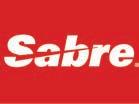
Cette situation est encore plus compliquée par l'attractivité et le succès remporté par des transporteurs à très bas coûts et des transporteurs à bas coûts (LCC) dans la plupart des grands marchés mondiaux d'aujourd'hui. 10 des 30 plus grandes compagnies aériennes ont maintenant un LCC au sein de leur groupe, et Airbus prévoit une augmentation constante de la pénétration des LCC au cours de la prochaine décennie, notamment dans les marchés tels que l'Asie/Pacifique et l'Europe où les lignes intrarégionales sont particulièrement populaires. Les transporteurs de réseau traditionnels et les transporteurs hybrides doivent examiner la meilleure façon de conserver leur base tout en captant leur part de voyageurs domestiques sensibles au prix des billets.
Digital Transformation: Helping The Industry Soar
Transformation digitaleAccompagner l’essor de l’industrie
and Airbus predicts a continued increase in LCC penetration during the next decade, particularly in markets such as Asia/Pacific and Europe where intra-region routes are especially popular. Traditional network and hybrid carriers must consider how best to retain their base while capturing their share of price sensitive, domestic travellers.
Growth in passengers globally will primarily come from the middle class, which is expected to double over the next 20 years. This demographic poses an interesting challenge for airlines as their appetite for high-tech, personalized experiences is greater than ever. Thanks to global brands such as Amazon, Google and Apple that have seamlessly integrated personalized experiences into their core products, these travellers not only expect, but demand, more control over the actual travel experience. They crave individualism and want to be inspired and delighted from the moment they begin researching their next trip.
La croissance du trafic mondial passagers sera principalement portée par la classe moyenne, qui devrait doubler au cours des 20 prochaines années. Ce segment démographique pose un défi intéressant aux compagnies aériennes car son appétit pour les technologies de pointe et les expériences personnalisées est plus grand que jamais. Grâce aux marques internationales telles que Amazon, Google et Apple qui ont intégré des expériences personnalisées �luides dans leurs principaux produits, ces voyageurs non seulement attendent, mais exigent plus de contrôle sur leur expérience de voyage. Ils ont soif de l'individualisme et veulent être inspiré et ravi dès l'instant où ils commencent à faire la recherche sur leur prochain voyage.
En raison de cette évolution des conditions du marché et des attentes des voyageurs,l'on observe des changements profonds dans le paysage de la distribution pour la première fois depuis de nombreuses années. Les progrès technologiques et les attentes des consommateurs sont les principaux facteurs qui ont vite amené les compagnies aériennes à repenser leurs méthodes de vente. L'IATA estime que d'ici 2021, la distribution directe représentera 45% des réservations (soit une progression de 12% par rapport à aujourd'hui).
Alors que les compagnies aériennes savent qu'elles doivent digitaliser leurs ventes au détail, les normes IATA, telles que New Distribution Capability (NDC) et ONE Order font également avancer l'agenda par la standardisation des schémas de messagerie et des normes de gestion des commandes au sein de l'industrie.
Airlines need to gain traction from a digital perspective to keep pace with today's savvy air travellers. Like many successful retailers, such as Amazon, Airbnb and Uber, there are many reasons and opportunities for airlines to make the digital-transformation shi�t.
Les compagnies aériennes doivent accélérer leur transformation digitale pour tenir la cadence des voyageurs aériens actuels qui maitrisent bien les technologies. Comme beaucoup de détaillants prospères, tels qu'Amazon, Airbnb et Uber, il y a beaucoup de raisons et d'opportunités pour les compagnies aériennes d'initier la transformation digitale.

Because of these changing market conditions and traveller expectations, there are massive changes in the distribution landscape for the first time in many years. Technological advances and consumer expectations have been the biggest accelerators in causing airlines to rethink how they sell. IATA contends that by 2021, direct distribution will account for 45 percent of reservations (up 12 percent from today).
While airlines know they must become more digitally savvy in how they retail and sell, IATA standards such as New Distribution Capability (NDC) and ONE Order are also pushing the agenda forward by standardizing the messaging schemas and ordermanagement standards across the industry. Digitally mature airlines will not only embrace these new standards, but they will go beyond them in imagining how best to reach today's connected traveller across all phases of their journey.

The good news for airlines is that emerging technologies present untapped opportunity that can lead to new levels of profitable growth while positively impacting the customer experience. Technologies such as artificial intelligence (AI) and machine learning will help airlines become smarter in decision-making, such as which �lights are the most relevant for a given passenger and how best to present o�fers for increased conversion. These predictive models will eventually become embedded within traditional technology systems, returning new, measurable value (by way of increased revenue and loyalty) for airlines that embrace them. A 2017 report by Sabre Labs unpacks the opportunity that AI could provide throughout the travel industry, even going so far as to say the question of AI adoption in travel is not ‘if,’ but ‘when.’

From an architecture and deployment perspective, cloud computing and microservice enablement will be two huge levers for future innovation. In Forrester's “Cloud Predictions for 2018,” the research firm estimates that the total public cloud market will exceed US$177 billion in 2018 and will continue to grow at a 22% compound annual growth rate (CAGR). Cloud deployment will be significant for airlines, as it allows for global proximity, on-demand scalability and new cost e�ficiencies.
Les transporteurs digitalement matures n'adopteront pas seulement ces nouvelles normes, mais iront plus loin pour imaginer la meilleure façon d'atteindre le voyageur connecté d'aujourd'hui tout au long toutes les étapes de leur voyage.
Les tendances technologiques créent de nouvelles opportunités
La bonne nouvelle pour les compagnies aériennes est que les nouvelles technologies présentent une opportunité inexploitée qui peut mener à de nouveaux niveaux de croissance rentable tout en créant un impact positif sur l'expérience du client.
Des technologies telles que l'intelligence artificielle (IA) et l'apprentissage machine (machine learning) aideront les compagnies aériennes à devenir plus intelligentes dans leur prise de décisions, comme par exemple savoir les vols les plus pertinents pour un passager donné et la meilleure façon de présenter des o�fres pour une conversion accrue. Ces modèles prédictifs seront finalement intégrés dans les systèmes technologiques traditionnels, pour créer une nouvelle valeur mesurable (par l'augmentation des recettes et de la fidélité des clients) pour les compagnies aériennes qui les adoptent. Un rapport publié par Saber Labs en 2017 dévoile l'opportunité que pourrait présenter l'IA pour l'ensemble de l'industrie du voyage, et va même jusqu'à a�firmer que l'adoption de l'IA dans le secteur du voyage n'est pas une question de savoir si elle se réalisera mais quand. Du point de vue architecture et déploiement, le cloud computing et le microservice seront deux grands leviers de l’'innovation future. Dans son rapport «Cloud Predictions for 2018», le cabinet de recherche Forrester estime que le marché du cloud public dépassera 177 milliards de dollars US en 2018 et continuera de croître à un taux annuel composé (TCAC) de 22%. Le déploiement du cloud sera important pour les compagnies aériennes, car il permet une proximité à l'échelle mondiale, une évolutivité à la demande et de nouvelles réductions de coûts.









Within underlying architectures, chief technology o�ficers globally are embracing microservices as way to loosely couple applications and services, while rapidly evolving the pieces of the surrounding technology stack. Companies such as Uber, Comcast Cable Communications, Amazon, eBay, Capital One and Walmart are all leveraging microservices to scale and innovate on top of their traditional technology. Ultimately, microservices will bring multiple benefits to airlines including application resiliency, enhanced monitoring and scalability.
Where does this leave the industry today? Many are calling for an industry-wide digital transformation – a disruption redefining core competencies and focusing on the interconnectivity of technology, people and processes to deliver a superior customer experience. This realignment will unlock new value in key areas of an airline's operation, allowing it to engage with customers in more personalized ways, while optimizing the products sold and the service experience of individual travellers.
The airline industry is not the first to benefit from a digital transformation. Companies such as Tesla, Nike, Boeing and Airbnb have all benefitted from a rethinking of how technology could transform their products, while engaging with their customers in a completely new way.
For example, within 48 hours of launching its new Tesla Model 3, Tesla experienced 276,000 preorders for the vehicle, totaling US$10 billion in potential sales and US$276 million in deposits. It took consumers only two minutes to preorder the car, and the deposits were substantial enough to partially crowd-fund the manufacturing of the new vehicle, which would take about 18 months to deliver. In doing so, Tesla successfully disrupted the automobile ecosystem. The biggest question is: How can airlines achieve this same level of success? It starts with embracing connected, intelligent and relevant platforms across the airline enterprise. Platforms can provide unique advantages to airlines, allowing them to use a common technology framework to integrate applications, share data and unify work�lows. Platforms are enablers of innovation because they can provide a consistent layer of communication to channels and allow for faster time to market.
A recent study by the Economist Intelligence Unit found that both IT and non-IT executives believe that the IT department should take a more active role in digital transformation. The same study concludes that only 7% of executives say that IT is leading the organisation's attempts to identify opportunities to innovate, while 35 percent believe they should. Perhaps this is because many companies lack the right underlying technology stacks to truly incite change. For airlines, it's not enough to have a huge data lake or even a cuttingedge application. Airlines need a ‘total-stack’ mentality when it comes to enabling new levels of optimisation and customer engagement.
This starts with not only having the right data, but having access to the right data underlying the airline enterprise. Today, airline data o�ten lives within ‘silos,’ or separate databases, that might be disconnected or isolated from other databases across the airline. An airline's ability to connect, or integrate, these databases is critical to
Dans les architectures sous-jacentes, les directeurs de la technologie partout dans le monde adoptent les microservices comme moyen de coupler plusieurs applications et services de façon souple, tout en assurant l'évolution rapide de la pile technologique environnante. Des entreprises comme Uber, Comcast Cable Communications, Amazon, eBay, Capital One et Wal-Mart exploitent les microservices pour l'évolution et l'innovation de leurs systèmes en plus de leurs technologies traditionnelles. En définitive, les microservices apporteront de multiples avantages aux compagnies aériennes comme la résilience des applications et l'amélioration de leur surveillance et de leur évolutivité.
Transformation digitale: Accompagner l'essor de l'industrie
Où mène-t-elle l'industrie? Beaucoup d'acteurs appellent de leurs vœux une transformation digitale de l'ensemble de l'industrie - une perturbation qui redéfinit les compétences fondamentales et un accent sur l'interconnectivité entre la technologie, les personnes et les processus pour o�frir une expérience client supérieure.
Ce réalignement va générer de la valeur nouvelle dans des domaines clés de l'exploitation des compagnies aériennes, leur permettant d'interagir avec des clients de façons plus personnalisées, tout en optimisant les produits vendus et l'expérience du service de chaque voyageur.
L'industrie du transport aérien n'est pas la première à bénéficier d'une transformation numérique. Des sociétés telles que Tesla, Nike, Boeing et Airbnb ont toutes tiré profit d'un réexamen de la façon dont la technologie pourrait transformer leurs produits, tout en interagissant avec leurs clients d'une manière complètement nouvelle.
Par exemple, 48 heures après le lancement de son nouveau Tesla Model 3, Tesla a reçu 276.000 précommandes pour ce véhicule, d'un montant total de 10 milliards de dollars en ventes potentielles et 276 millions de dollars en dépôts. Il n'a fallu que deux minutes pour que les clients précommandent la voiture, et les dépôts étaient su�fisamment importants pour partiellement financer par crowd-fund la fabrication du nouveau véhicule, qui devait prendre environ 18 mois avant sa livraison. Ce faisant, Tesla a réussi à perturber l'écosystème automobile.
La grande question est la suivante: Comment les compagnies aériennes peuvent-elles atteindre ce même niveau de succès? Le point de départ est l'adoption de plates-formes connectées, intelligentes et pertinentes dans toute la compagnie aérienne. Ces plates-formes peuvent leur fournir des avantages uniques, leur permettant d'utiliser un cadre technologique commun pour l'intégration des applications, le partage de données et l'unification les �lux de travail. Les plates-formes sont des facteurs habilitants de l'innovation, car elles peuvent fournir une couche uniforme de communication aux canaux et permettre une commercialisation plus rapide.
La technologie comme moteur de la transformation digitale
Une étude récente de l'Economist Intelligence Unit a constaté que tant les cadres informaticiens que non-informaticiens estiment que le département informatique devrait jouer un rôle plus actif dans la transformation digitale. La même étude a conclu que 7% seulement des responsables reconnaissent que la TI est au cœur des tentatives de l'organisation d'identifier les possibilités d'innovation, alors que 35% estiment que ce devrait être le cas. La raison en est peut-être que de nombreuses entreprises ne disposent pas d'une infrastructure technologique adéquate pour vraiment susciter le changement.
Pour les compagnies aériennes, il n'est pas su�fisant d'avoir une imposante base de données ou même une application d'avant-garde. Elles doivent adopter une approche englobante quand il s'agit de permettre d'autres niveaux d'optimisation et d'engagement avec le client.
Les données
Tout d'abord il faut non seulement disposer de bonnes données, mais aussi avoir accès aux bonnes données sous-jacentes à l'entreprise de transport
develop a common understanding of what's happening in real-time across the operation. It is estimated that as many as 70 individual systems are required for airlines to operate every day – that's not only a lot of data, but it's a lot of opportunity for data to become out of synch and inaccurate.
The types of data within an airline are diversified as well. While airlines have traditionally managed more structured, transactional data, airlines are being met with a new challenge: how to “glue” multiple types of structured and unstructured data (such as socialmedia data) together to truly gain a full picture of the customer. Without a common, cohesive picture of every customer, analysts are blind to the insights and opportunities for personalisation that remain hidden within the data. Digital airlines will not only understand how to harness structured and unstructured data, but they will leverage smart tools and platforms to help them gain control of real-time insights to make better decisions.
Airlines today use a variety of methods to update, store and send this complex data back-and-forth to front-end applications. Over time, the proliferation and evolution of messaging languages has le�t a tangled and complex reality for many airlines when it comes to communication between the layers. Fortunately, the rise of standard so�tware developer kits (SDKs) and intelligent middleware are beginning to make it easier for digital airlines to simply connect their back-end data to their front-end applications and customer touchpoints.
When it comes to analyst tools, front-line employee interfaces and channel touchpoints, airlines should weigh their ability to deliver the right data to the right customer or application at the right time. Ability to execute on a relevant, intelligent omni-channel experience is perhaps the most important piece of bringing digital transformation to life.
Digitally mature organisations will have focused e�forts across each of these layers, further amplifying the impact of their enterprise technology. Without the right underlying technology, airlines will struggle to realize their vision of digital transformation. On the other hand, putting the right technology components in place will unlock new opportunities, resulting in new levels of customer acquisition and retention, game-changing innovation and bottom-line growth.
aérien. Aujourd'hui, les données des compagnies aériennes existent souvent en vase clos ou dans des bases de données distinctes, qui pourraient être déconnectées ou isolées des autres bases de données au sein de la compagnie aérienne. La capacité d'une compagnie à relier, ou intégrer, ces bases de données est essentielle pour développer une compréhension commune de ce qui se passe en temps réel dans toute l'exploitation. On estime qu'environ 70 systèmes individuels sont requis pour l'exploitation quotidienne d'une compagnie aérienne - cela ne représente pas seulement un grand volume de données, mais également de nombreuses occasions de produire des données désynchronisées et inexactes.
Les types de données qu'on trouve au sein d'une compagnie aérienne sont également diversifiés. Ayant toujours géré des données transactionnelles, plus structurées, les compagnies aériennes font face à un nouveau défi : comment “coller” ensemble plusieurs types de données structurées et non structurées (telles que les données issues des médias sociaux) pour vraiment avoir une image complète du client. Sans un portrait commun et cohérent de chaque client, les analystes sont aveugles aux idées et possibilités de personnalisation qui restent cachées dans les données. Les compagnies aériennes digitales pourront non seulement comprendre la manière d'exploiter les données structurées et non structurées, mais aussi tirer parti des outils et des plates-formes intelligents qui leur permettront de prendre le contrôle des renseignements en temps réel afin d'arriver à de meilleures décisions.
Les intergiciels
Aujourd'hui, les compagnies aériennes utilisent une variété de méthodes pour mettre à jour, stocker et envoyer ce va-et-vient complexe de données aux applications front-end. Au fil du temps, la prolifération et l'évolution des langages de messagerie a tissé une réalité enchevêtrée et complexe pour beaucoup de compagnies aériennes lorsqu'il s'agit de communication entre les di�férents niveaux. Heureusement, l'augmentation des kits de développement de logiciels (SDK) et d'intergiciels intelligents commence à rendre plus facile pour les compagnies aériennes la connexion de leurs données à leurs applications front-end et aux points de contacts clients.
En ce qui concerne les outils de l'analyste, les interfaces et canaux de contact des personnels de première ligne, les compagnies aériennes doivent évaluer leur capacité à fournir les bonnes données au bon client ou à la bonne application au bon moment. La capacité de réaliser une expérience omnicanaux intelligente est peut-être la façon la plus importante d'apporter une transformation numérique à la vie.
Des organisations digitalement matures auront concentré leurs e�forts sur chacune de ces couches, amplifiant d'avantage l'impact de leurs technologies d'entreprise. Sans l'usage d'une technologie adéquate, les compagnies aériennes auront des di�ficultés à réaliser leur vision de la transformation

While airline profitability remains at an all-time high, digging underneath those numbers reveals a di�ferent trend: airlines are getting less revenue per available seat mile than they were one year ago, and according to an analysis by Forbes, the revenue made from ancillary sales is not enough to o�fset the decline in seat revenues.
This means that it's no longer su�ficient for airlines to simply revenue manage every seat. Airlines must embrace intelligent technologies to become creative about how – and where – they can capture additional revenue.
By digitally transforming traditional commercial planning and retailing practices, airlines can infuse intelligent decision support to become smarter about:
• How they configure cabins and improve network connectivity,
• How to optimally price seats and ancillaries closer to the shopping session,
• How they package and display personalized o�fers across all sales channels.
Each of these represents an area where, with the right technology and processes, airlines can squeeze additional income to help close the revenue gap.
On the operational side, there remains intense e�fort to improve fuel e�ficiency – IATA currently estimates that airspace and airport ine�ficiencies alone waste approximately 5% of excess fuel burn each year. Fuel and labor remain the top two cost drivers for airlines globally, with 2018 total employment estimated to exceed 2.7 million people, an increase of 2.6% compared to 2017. Together, these trends signify additional upward pressure on unit costs and additional squeezing on airline profit margins.
Clearly, the opportunity for digital transformation is abundant in the operational space as well. By connecting and integrating key operations functions – �light planning, as well as operations, airport and crew management – airlines can use digital technologies to enhance decision-making, leading to optimal operational plans that reduce fuel waste and e�ficiently utilize crewmembers. Connecting the operation also facilitates a deeper level of collaboration between operational teams, allowing each team to consume and provide inputs to each other faster and more cohesively than ever before. Imagine a future where the operations functions are pulled more tightly together with unified technology and business processes. A common, connected platform would not only increase situational awareness across functions, but result in more confident decisionmaking that takes into consideration what's best for the holistic operation.
For decades, airlines have been awash in data. Consultancy Oliver Wyman predicts that annual data generation could reach 98 billion terabytes by the year 2026. The same article also claims that the airline industry has reached an in�lection point and that traditional tools can no longer meet the needs of digital airlines, stating that, “With hundreds of planes, thousands of �lights and millions of

digitale. D'autre part, la mise en place des éléments corrects de technologie permettra d'exploiter de nouvelles possibilités, donnant lieu à de nouveaux niveaux d'acquisition et de fidélisation des clients, des innovations révolutionnaires et une augmentation des bénéfices.
Possibilité 1: La maximisation des recettes de bout-en-bout Alors que la rentabilité des compagnies aériennes reste à un niveau record, un examen plus approfondi des chi�fres révèle une tendance di�férente: les compagnies aériennes obtiennent moins de revenus par siège-mile qu'ils n'en réalisaient il y a un an, et selon une analyse réalisée par Forbes, les recettes provenant de ventes auxiliaires ne sont pas su�fisantes pour compenser la baisse de revenus par siège.
Cela signifie qu'il n'est plus su�fisant pour les compagnies aériennes de simplement gérer les recettes par siège. Les compagnies aériennes doivent adopter les technologies intelligentes pour devenir créatives quant à la manière - et l'endroit - où elles peuvent capturer des recettes supplémentaires.
En digitalisant les pratiques traditionnelles de planification commerciale et de vente au détail, les compagnies aériennes peuvent infuser un appui intelligent à la décision pour devenir plus intelligentes en ce qui concerne :
• La configuration des cabines et l'amélioration de la connectivité du réseau,
• L'optimisation de la tarification des sièges et des produits auxiliaires juste avant la session d'achat,
• La présentation et l'a�fichage des o�fres personnalisées à travers tous les canaux de vente.
Chacune de ces options représente un domaine où, avec la technologie et les processus adéquats, les compagnies aériennes peuvent se faire des revenus supplémentaires pour combler le manque à gagner.
Possibilité 2: La connexion de l'entreprise pour l'excellence opérationnelle
Sur le plan opérationnel, des e�forts soutenus restent à faire pour améliorer l'e�ficacité énergétique - l'IATA estime actuellement que le manque d'e�ficacité dans l'espace aérien et au niveau des aéroports à lui seul conduit à une perte d'environ 5% des consommations additionnelles de carburant chaque année. Le carburant et la main-d'œuvre restent les deux principaux facteurs de coût pour les compagnies aériennes dans le monde, le nombre total d'employés étant estimé à plus de 2,7 millions de personnes en 2018, soit une augmentation de 2,6% par rapport à 2017. Ensemble, ces tendances indiquent une pression élevée sur les coûts unitaires et une pression supplémentaire sur les marges bénéficiaires des compagnies aériennes. De toute évidence, les possibilités de transformation numérique sont également abondantes dans le domaine opérationnel. En reliant et en intégrant les fonctions d'exploitation importantes telles que la planification des vols, ainsi que la gestion de l'exploitation, des opérations dans les aéroports et des équipages, les transporteurs peuvent utiliser les technologies
employees and passengers, there is now too much data and too many variables for humans to sort through fast enough to fix problems or even prioritize potential threats.”
Infusing the connected, intelligent and relevant digitaltransformation tenants into data and analytics practices is necessary to begin to harness and act on this vast amount of data. For airlines, future-ready data platforms will begin to close the data divide within the airline enterprise. Through real-time data integration, big-data platforms will not only consume structured and unstructured data, but they will be sophisticated enough to take action on business rules across all channels and touchpoints.
These types of big-data platforms should not only be smart, but they should be further linked and integrated with other bigdata appliances, data warehouses and various analytical tools and applications. Together, these data tools and platforms will form a sophisticated decision-making system, able to trigger the experiences that matter most to each individual customer.
While technology is arguably the most important aspect of digital transformation, culture, collaboration and change management, all have a role in achieving success. McKinsey & Company advises that even senior-management commitment is not enough. The consultancy outlines that it takes clear, ambitious targets, a high-calibre launch team, agile processes and a digital culture to transform.
It will be up to every airline to define what digital transformation means for them. While opportunities abound, digital transformation is not an exact science, and the methods that are successful in one region may not be replicated globally. It will ultimately be up to airline leaders to lay out a roadmap and embark on a digitaltransformation journey to determine whether their carriers prosper or fade.
Stan Boyer, vice president of customer solutions for Sabre Airline Solutions, has held various management and leadership positions for Sabre during the last 20 years. He earned a bachelor's degree in agricultural sciences from the University of Illinois, UrbanaChampaign. He also has a master's degree in Linguistics and an MBA from the University of Texas at Arlington. For additional information about airline digital transformation, contact Stan at stan.boyer@sabre.com
digitales pour améliorer la prise de décision, en vue des plans opérationnels optimaux permettant de réduire le gaspillage de carburant et d'utiliser e�ficacement les équipages. Connecter les opérations facilite également un niveau plus profond de collaboration entre les équipes opérationnelles, permettant à chacune d'elles de consommer et de fournir des données à l'autre plus rapidement et de façon plus cohérente que jamais.
Imaginez un avenir où les fonctions des opérations sont plus étroitement reliées grâce à une technologie et des processus d'entreprise unifiés. Une plate-forme commune, connectée permettrait non seulement d'accroître la prise de conscience de l'ensemble des fonctions, mais conduirait aussi à une prise de décisions plus sûres, qui tiennent compte de ce qu'il y a de mieux pour l'exploitation dans son ensemble.
Possibilité 3: Tirer parti du Big Data et de l'analytique Pendant des décennies, les compagnies aériennes ont été inondées de données. Le cabinet de conseil Oliver Wyman, prédit que la production annuelle de données pourrait atteindre 98 milliards de téraoctets d'ici 2026. Le même article a�firme également que l'industrie aérienne a atteint un point d'in�lexion et que les outils traditionnels ne peuvent plus répondre aux besoins des compagnies aériennes digitales, a�firmant que, «avec des centaines d'avions, des milliers de vols et des millions d'employés et de passagers, il y a maintenant trop de données et trop de variables pour que les humains puissent les analyser assez rapidement pour corriger des problèmes ou même prioriser les menaces potentielles.»
Associer les locataires connectés, intelligents et pertinents dans le cadre de la transformation digitale, aux pratiques de collecte et d'analyse de données est nécessaire pour commencer à maîtriser et à agir sur cette quantité vaste de données. Pour les compagnies aériennes, les plates-formes de données tournées vers l'avenir commenceront à combler le fossé des données au sein de l'entreprise. Grâce à l'intégration des données en temps réel, les plates-formes big data non seulement vont consommer des données structurées et non structurées, mais aussi elles seront su�fisamment sophistiquées pour prendre des mesures relatives aux règles commerciales sur tous les canaux et points de contact.
Ces types de plates-formes big data ne devraient pas seulement être intelligentes, elles devraient aussi être plus étroitement reliées et intégrées avec d'autres appareils big data, entrepôts de données et di�férents outils d'analyse et applications. Ensemble, ces outils et plates-formes de données formeront un système sophistiqué de prise de décisions, capables de déclencher les expériences qui comptent le plus pour chaque client.
La transformation digitale: Un test de collaboration et d'innovation

Bien que la technologie soit sans doute l'aspect le plus important de la transformation digitale, la culture, la collaboration et la gestion du changement ont tous un rôle à jouer pour réussir. McKinsey & Company indique que même l'engagement des cadres supérieurs n'est pas su�fisant. Le cabinet de conseil souligne qu'il faut des objectifs clairs et ambitieux, une équipe de lancement de grand calibre, des processus �lexibles et une culture numérique pour une transformation réussie.
Il appartiendra à chaque compagnie aérienne de définir ce que signifie pour elle la transformation digitale. Bien que les possibilités abondent, la transformation numérique n'est pas une science exacte, et les méthodes qui réussissent dans une région ne peuvent pas nécessairement être reproduites à l'échelle mondiale. En fin de compte, il reviendra aux responsables des compagnies aériennes de tracer une feuille de route et s'engager sur le chemin de la transformation digitale pour déterminer si leurs compagnies vont prospérer ou disparaitre.
Stan Boyer, vice-président chargé des solutions client chez Sabre Airline Solutions, a occupé divers postes de responsabilité à Sabre au cours des 20 dernières années. Il a obtenu une licence en sciences agricoles à l'Université de l'Illinois, Urbana-Champaign. Il est également titulaire d'une maîtrise en linguistique et d'un MBA de l'Université du Texas à Arlington. Pour plus d'informations sur la transformation digitale d'une compagnie aérienne, veillez contacter Stan à stan.boyer@sabre.com
On the 7th March 2018, Rolls-Royce announced their financial results for 2017. Exceeding expectations, the UK listed company bounced back producing a £4.9bn operating profit with underlying profits of £1bn and a tripling of free cash �low to £273m, which is expected to reach £450m in 2018. This good news saw Rolls-Royce's shares rise by 15%, securing confidence in the company's renewed strategies and refreshed leadership team.
In particular, 2017 saw notable achievements for Rolls-Royce's Civil Aerospace division. With over 4,400 engines in active service at the end of 2017, up 7% on 2016, RollsRoyce is on track to double the number of its widebody engines in service by 2025, and increasing their global market share in the widebody sector to more than 50% early within the next decade.
Rolls-Royce powered aircra�t have continued to demonstrate their capability across a wide variety of operations across the

globe, from low-cost carriers to full-service airlines, and from short-haul domestic and regional, through to ultra-long range intercontinental operations.
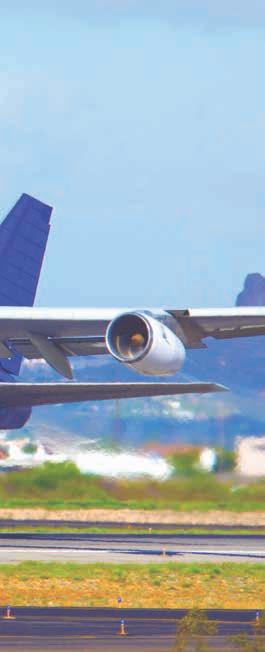
programmes. The new Trent XWB-97, which delivers greater thrust to power the Airbus A350-1000, entered service in February 2017. The latest version of the Trent 1000, the Trent 1000-TEN, entered into service on Boeing's 787-9 in November and very recently on the first Boeing 787-10. We also saw the first test �light of Airbus’ A330neo exclusively powered by the new Trent 7000. During the year Rolls-Royce also celebrated the 1millionth hour �lown by their Trent XWB-84, which also achieved unprecedented levels of reliability (99.9% dispatch reliability).
These developments are born from RollsRoyce's vision to pioneer the power that matters to customers, perfectly positioning the company to support Africa's rapidly growing civil aviation industry with more e�ficient, reliable & cleaner portfolio of products and solutions.
The introduction of CareStore now provides the customer with an informative gateway to the full range of Rolls-Royce's services, from T&M all the way up to TotalCare in a portfolio that can meet the needs of an increasingly diverse customer base. This is supporting customers with greater choice and helping them make more informed decisions.
The business delivered a record 483 widebody engines, up 35% on 2016. In Africa, Air Mauritius celebrated the delivery of their first Airbus A350-900 powered by Rolls-Royce's XWB engines; Ethiopian Airlines received more Airbus A350-900s and Boeing 787s, including their first Boeing 787-9 aircra�t; and in addition, two more Airbus A330s were delivered to South African Airways. All powered by Rolls-Royce. Significant milestones were also achieved in each of the three new large engine
In June, the Airline Aircra�t Availability Centre was opened. Using industry-leading data analytics, the Centre can proactively plan engine maintenance, complementing the existing global network of Customer Service Centres which provide in-depth expertise in their local markets. Online apps were launched for both commercial and business aviation customers to provide real time service information and better insight into their engines, enabling airlines to optimise performance.
The research and development team at Rolls-Royce are known for pioneering innovation. The company continues to uphold its reputation as one of the world's leading industrial technology companies by substantially investing in developing future technologies necessary to winning positions on next generation platforms for both large engines and for future business jets.
Rolls-Royce has defined a vision for the future of aircra�t power that will help deliver travellers more reliably and more e�ficiently than ever before.
Author | Auteur: Rolls-RoyceGood progress was reported on new engine architecture demonstrator programmes. The Advance3 demonstrator successfully completed initial ground test runs and the UltraFan® Power Gearbox successfully completed a high power test run to a record breaking 70,000 horse power. In addition, Rolls-Royce announced its partnership with Airbus and Siemens to develop the E-Fan X electrical propulsion technology demonstrator.
Rolls-Royce has defined a vision for the future of aircra�t power that will help deliver travellers more reliably and more e�ficiently than ever before. Their IntelligentEngine vision is based on a belief that the worlds of product and service have become so closely connected, they are now almost inseparable. This trend was first identified when Rolls-Royce introduced the market-defining TotalCare® service in the 1990s and, since then, advancements in digital capability have accelerated this change and further blurred the boundary between the two.
This concept will enable Rolls-Royce to find new ways of pioneering power, whether that is through its engines installed today, through its future UltraFan® engine design, or even through the hybridelectric concepts of the future. By the end of this year Rolls-Royce will be set to receive more than 70 trillion data points from its inservice �leet each year. Harnessing the power of this data is central to delivering the IntelligentEngine and developing an engine which is connected, contextually aware and comprehending.
During the year, there were also challenges as Rolls-Royce managed some Trent 1000 in-service issues. Their solutions involve working closely with customers and using advanced analytics to support a
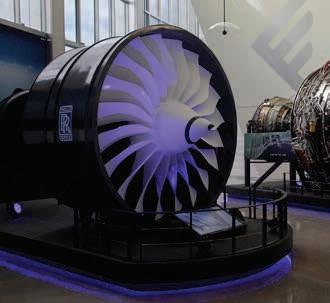

proactive engine maintenance programme with greater investment in facilities and people to minimise disruption.
Looking ahead into 2018, Rolls-Royce will be present in 15 countries across Africa and have over 60 widebody aircra�t in service with another 50 in backlog. New customer, Air Tanzania will take delivery of their first Boeing 787-8 and Ethiopian Airlines will receive four more A350-900s and another two Boeing 787-9s, all powered by Rolls-Royce engines. And, Air Mauritius will be one of the very first airlines in the world to receive their first of two Airbus A330neos powered by the Trent 7000.





787 DREAMLINER. A BETTER WAY TO FLY. The industry-leading technology of the 787 Dreamliner is creating remarkable opportunities for airlines around the world. We call it the Dreamliner effect. Its unparalleled fuel efficiency and range flexibility enable carriers to profitably open new routes as well as optimize fleet and network performance. And for their passengers, an experience like none other in the air. Put the Dreamliner effect to work for you. That’s a better way to fly.
boeing.com/787


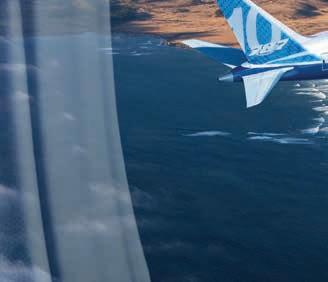
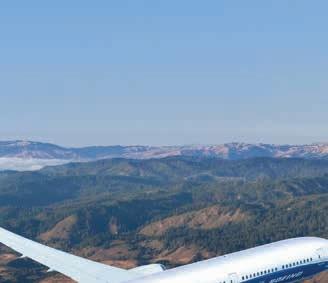
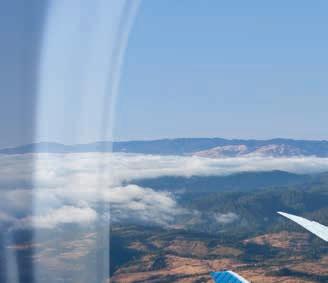

We have entered the Fourth Industrial Revolution – an era of constant connectivity and artificially intelligent workforces – where there has never before been such a major opportunity to be closer to and understand our customers. We witnessed some key macro trends – such as even more reliance on social media, and the importance of empathy for brand a�finity – but also looked to how we can improve our understanding of customers on a micro level, harnessing technology where possible to achieve this. The saying goes that everybody has a price. But to have a price, everybody has to have a value.
For airline customers, this is the sweet spot where they feel the balance between product, service and convenience is achieved. Each time a customer searches for a �light, they bring their individual values to the search.
Amadeus’ study, Embracing airline digital transformation: a spotlight on what travellers value, reveals that customers value three main things when travelling: product, service and convenience.

By applying the paradigm to di�ferent types of travel personas, we can create a clear picture of how to upsell something of value to them. The more a traveller values one or more of these components, the greater the opportunity for airlines to market intuitively so the customer purchases something of value to them.
• Product: “It's a long �light – I want as much legroom as possible.”
• Service: “I want to feel like my holiday has started as soon as I step on the plane.”
• Convenience: “I need a direct �light; I don't have time for a stopover.”
On any given journey, a customer may place a di�ferent value on each component, depending on the context of their �light. The budget traveller will think: “I need the cheapest �light possible, I can't a�ford to splash out, and I'm not in a rush.”

For the business traveller, convenience will likely have the most importance. He'll want to travel to his destination from the closest airport and won't have time for a stopover. Product is key for the frequent �lyer, who wants to �ly on a comfortable aircra�t with ample space, whereas the family traveller will place a higher value on service. “I'm travelling with a baby for the first time. I'll need some support before and during the �light, so I want friendly, helpful sta�f.”
While travellers bring their own values to the �light booking process, they are open to being

A quick 360-degree view of the air travel market

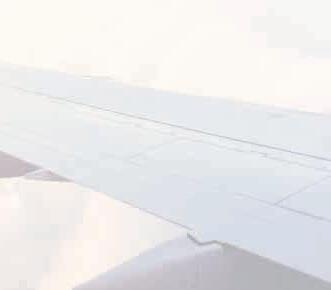
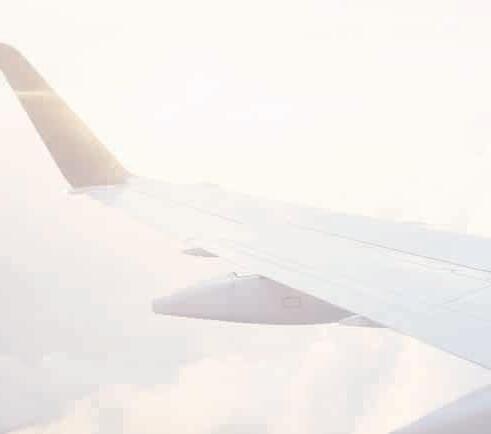
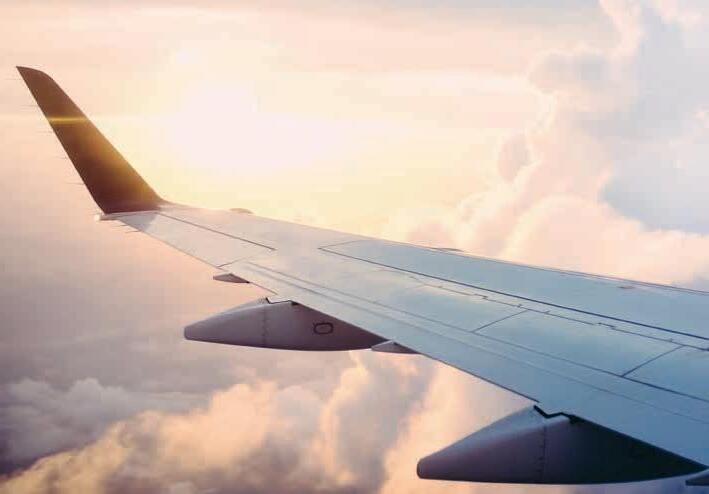
This report will provide you with:
• an overview of 2017 in air travel and an introduction on key trends to help the industry innovate further in 2018 highlights on global initiatives, regional views, traveller insights and key industry topics


a selection of case studies, latest industry statistics and forecast a wide range of quotes and inputs from industry and Amadeus leaders


sold something they didn't know they wanted – as long as the purchase makes sense.
This provides an opportunity for airlines to present their o�fers in ways that move beyond price, leveraging data to provide a more personalised o�fer that improves conversion, satisfaction, and brand loyalty. However, currently travellers still find the choices to be overwhelming when they search for �lights. Our research found that only 14% of travellers find it easy to compare airline o�fers based on attributes other than price. Yet these components are key when it comes to making the decision. In an online ecosystem of overwhelming choice, airlines that exert in�luence over a traveller's decision-making process, and help to remove some of the complexity, are the ones that will appear to have the most attractive o�fering.
The saying goes that everybody has a price. But to have a price, everybody has to have a value.
As a proud member of AFRAA and IATA, CellPoint Mobile is committed to helping African airlines implement mobile sell- and pay-side solutions to capture new revenues, increase sales volumes and create seamless travel experiences for their customers, with fast, easy and secure interactions and transactions. With many African airlines serving underbanked populations, alternative payment methods (APMs) are critical to commerce across the continent. Our solutions connect airlines to global and regional APMs, and create a simple and e�fective path to purchase on travellers’ mobile devices. This is an exciting time for airlines across Africa, and our goal is to make travel easier for all carriers – and for their passengers – with the most e�ficient mobile booking, ticketing and payment solutions.
This year, we have made it a priority to grow relationships with airlines and travel merchants across Africa. As we enter the second half of 2018, I wanted to share some details of what CellPoint Mobile is doing both regionally and globally.

Airline sector advancements
CellPoint Mobile was in Zanzibar recently for the 7th Aviation Stakeholders Convention. The event is an initiative of AFRAA to bring together operators and service providers in the airline industry, with the view to foster dialogue, build sustainable networks in supply chain management, create a competitive environment for business and improve the aviation support base on the African continent. We look forward to building new partnerships at future AFRAA conferences (more on that below).
Among the other airline industry conferences that CellPoint Mobile has a presence at, we attended Airline Information's 4th Mega Event Asia-Pacific conference in Singapore. One of the questions we posed at the conference – and to the wider airline sector – is whether airlines have the strategies and solutions in place to collect more revenues through the mobile channel, at every point in the passenger journey. This is the fundamental opportunity we've built our solutions for, be it with mobile booking or mobile payments. We help airlines and other travel providers make travel easier for passengers, by streamlining travel processes that occur on their mobile devices, and by turning every touchpoint into an opportunity for mobile revenue. This is the vision that motivates us to keep moving the airline industry and the travel sector forward.



Last November, CellPoint Mobile was honoured to be part of the 49th Annual General Assembly for the African Airlines Association (AFRAA)
in Rwanda. As a proud member of AFRAA, we were delighted to meet with representatives from African airlines and discuss the continent's growing opportunities for mobile commerce. The presentation can be accessed via the link: https://speakerdeck.com/cellpointmobile/ cellpoint-mobile-afraa-aga-presentation-nov-2017

Following up on AFRAA, we made an appearance on CNBC Africa to discuss how the region's airlines can tap into digital commerce to drive growth (the interview can be accessed online via the link: https://www.cnbcafrica.com/videos/2017/12/05/how-africanairlines-can-tap-into-e-commerce-for-growth/); we look forward to developing new opportunities to help African carriers build out their mobile capabilities and revenues through this decade and into the next.
Since last year's AFRAA General Assembly, 23 African countries have launched the Single African Air Transport Market (SAATM) initiative, liberalizing air travel across the continent. This ‘Open Skies’ initiative by the African Union (AU) should pave the way for improved connectivity between markets, reduced ticket prices, more jobs, and greater freedom of movement for people.
CellPoint Mobile applauds this initiative and the leadership of the AU and its member states that brought it to fruition. Liberalization policies like SAATM – as with the EU-US Open Skies Agreement and ASEAN Open Skies before it – provide immense benefits to airlines and other companies in the travel sector, and to consumers and travellers in the region. At a fundamental level, they make travel easier, which is precisely what CellPoint Mobile endeavors to achieve through mobile-first solutions.
The rail sector and ground transportation
CellPoint Mobile has long been a provider of mobile solutions to the ground passenger transportation industry, especially the rail sector, and 2018 has provided another opportunity for re-assess where the industry is headed. Like airlines, rail operators are looking to expand and increase their share of the travel market (and customer wallet), but first they need to sell a new generation of travellers on the


This is an exciting time for airlines across Africa, and our goal is to make travel easier for all carriers – and for their passengers – with the most e�ficient mobile booking, ticketing and payment solutions.







convenience, comfort and economy of rail. The easier it is for travellers to search, book and pay for their rail travel plans, the easier it will be for the rail industry to strengthen itself as an attractive, mainstream travel option.
Similar challenges and opportunities face other ground transportation operators, including buses and ferries. Mobile ticketing and mobile payments are ‘game changers’ for bus and ferry operators because mobile requires no special or time-consuming hardware investments. Mobile devices are ubiquitous today and travellers depend on them for information, directions, schedules, station maps, delay alerts and so much more. Today, mobile user experience is becoming critical to passenger experience across all travel and transport sectors, including airlines – and this will continue to be a priority for us and the customers we serve.
Hospitality is another industry group on our 2018 priority list with major opportunity (and an urgent need) for additional mobile capabilities. Just last year, Marriott rolled out mobile check-in across 300 hotels in Asia-Pacific, including Hong Kong. This represents the standard of connected travel that mobile consumers increasingly expect – a seamless, frictionless experience from beginning to end of a journey. Over the last year, we have broadened our reach across the overall travel and tourism industry, adapting our core booking and payment solutions to the unique needs of the hospitality industry, which encompasses hotels, music venues, sporting arenas, convention centres, resorts, entertainment and more.

Globally, the travel sector continues its steady advance to becoming a mobile-first industry. In 2018, digital travel worldwide will increase 10.4% to reach $676B in sales, eventually climbing to $855B by 2021.
In the US, mobile already drives 40% of digital travel sales. Mobile commerce is truly transforming how we search, book, pay for and manage travel, and how travel providers drive and maximise revenue. Africa is a fast-emerging market for air travel, tourism and mobile payment capabilities. In South Africa, for instance, nearly a quarter of the population have shopped online, and travel is the second most popular type of purchase (45%). In Kenya, 26% of the population participates in e-commerce, compared to only 17% of the global population. In fact, Africa has the highest growth rate of mobile broadband penetration in the world and that is something that collectively, we must take advantage of while benefiting our end customers.

I look forwarding to telling you more about our work within the AFRAA community and providing guidance on the right digital, mobile and payments solutions that will meet your passenger expectations and increase your airline's revenues.

Embraer, the third biggest aircra�t manufacturers in the world, staged another successful Airline Business Seminar on 27 & 28 March in Sandton, South Africa.
The seminar was attended by more than 100 delegates, representing 25 airlines from all over the African continent. Delegates from the major leasing companies as well as from the finance industry were also part of the two days conference.
The topic of this year was ’ From theory to practice’. Indeed, a�ter a first day focused on various subjects of the aviation industry, all the delegates had the unique occasion to tour 1 ERJ and 1 E-Jet from SA Airlink that were on static display in front of the Embraer brand new training centre at OR Tambo Airport in Johannesburg.
During the opening of the Seminar, Raul Villaron, the new Embraer VP for Africa & Middle-East urged the African airlines to ‘right-size’ their �leet. He pointed out that 95% of intra-Africa �lights depart with less than 150 pax on board and therefore are losing money due to their low load factors and high operating costs. The other aspect that was emphasized is the importance to train local workforce in order to address the growing African airlines needs while supporting the local economy. The opening of the new Embraer training centre in Johannesburg is pushing into this direction.

On the speakers’ side, SA Airlink, South African Airways, Fastjet and IATA shared their views during stimulating presentations. Sylvain Bosc, CCO of Fastjet, explained why they replaced their A319 with smaller E-Jets and ERJs aircra�t, right sizing their �leet and returning to profitability for the first time in years. A more theoretical session on �leet planning also took place with Paul Clark, the author of the best seller book ‘Buying the big jets’, followed by a signature session of his book. The participants to the seminar also had the chance to listen to the Minister of Aviation of Ghana, Hon. Cecilia Dapaah, who delivered a speech on the project of the government of Ghana to revive a national airline. The panel on ‘Financing growth’ was very animated thanks to the participations of the various stakeholders such as lessors (Aercap, NAC), institutions (Afrexim, BNDED) and banks (Investec, Nedbank). Finally, an inspiring and refreshing presentation was done by Uber on the ‘Uber Elevate’ or ‘Flying Taxi’ project, reinforcing the existing partnership between Uber and Embraer. Great delegates and excellent opportunities to network were among the highlights of this successful event where airlines, lessors and banks where given the unique occasion to interact all together.
The location of the next edition of the Embraer Airline Business Seminar shall be revealed soon.

The A330 has become a popular addition to many global airline �leets including those in Africa.


L'A330 s'est avéré très apprécié dans plusieurs �lottes de compagnies aériennes à travers le monde, y compris celles d'Afrique.
Aircra�t with good market mass tend to be very liquid, as the opportunities to transition aircra�t from one operator to another are numerous. Les avions pressentant un bon ratio ont tendance à être très liquides, car les possibilités pour ces appareils de passer d'un opérateur à un autre sont nombreuses.
Developed from the Airbus A300-600 in parallel with the four-engined A340, and originally conceived as a low gross weight small-to-medium regional and medium-haul widebody aircra�t intended for high density operations, the A330-300 has undergone a number of incremental improvements over its 20 year production history, resulting in a relatively high gross weight, operationally�lexible aircra�t serving both intra-regional and long haul markets.
The A330-300 is a very popular choice for many Asia Pacific and European carriers and increasingly Africa too, proving to be a versatile aircra�t serving both intra-regional and long-haul markets. Early variants, produced from 1993 through 1998, have a maximum take-o�f weight (MTOW) of 212 tonnes through 217 tonnes, and a range profile between 3,900 nm and 4,300 nm. Later variants have introduced incrementally increased MTOWs over the intervening years of 233, 235 and, available from 2015, 242 tonnes, with a higher fuel capacity option increasing range to 6,100 nm. More recently,
Développé à partir de l'Airbus A300-600 en parallèle avec le quadriréacteur A340, et à l'origine conçu comme petit - moyen appareil régional avec une faible masse brute et un fuselage large moyen-courrier destiné à des lignes à forte densité, l'A330-300 a subi plusieurs améliorations graduelles au cours de ses 20 ans de production, avec comme résultat un avion à masse brute relativement élevée et dotée d'une souplesse opérationnelle, desservant à la fois les marchés intra-régionaux et longcourriers.
L'A330-300 est très prisé par beaucoup de transporteurs d'Asie-Pacifique et d'Europe, et de plus en plus d'Afrique, pour sa polyvalence sur des liaisons aussi bien intra-régionales que longcourriers. Les premières variantes construites entre 1993 et 1998, ont une masse maximale au décollage (MTOW) de 212 tonnes jusqu'à 217 tonnes et un rayon d'action de 3.900 NM à 4.300 NM. Les variantes les plus récentes ont vu leurs MTOW augmenter progressivement au fil des années passant à 233 tonnes, puis à 235 tonnes et, à partir de 2015, à 242 tonnes, avec l'option d'une plus grande capacité en carburant allongeant le rayon d'action jusqu'à 6.100 NM.
Airbus has produced a new lower-weight Regional variant (200 tonnes) aircra�t that is optimised for use on domestic and regional routes in high growth markets such as China and has launched a re-engined and upgraded A330neo family with the first development aircra�t, an A330-900 variant, that �lew in October 2017.
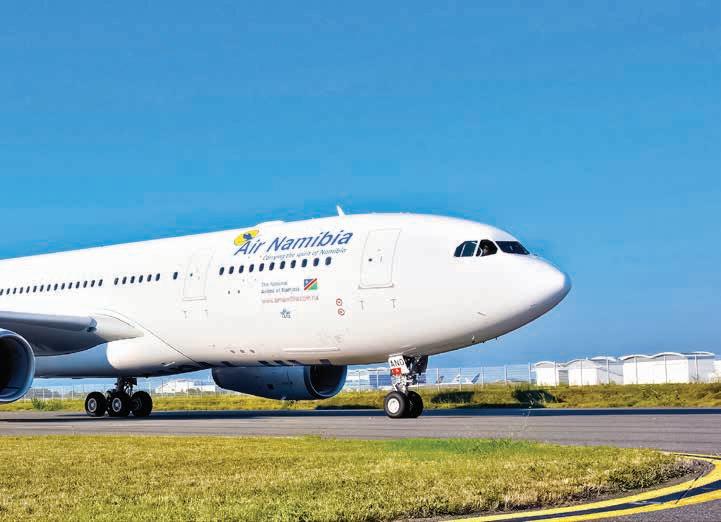
The A330ceo (current engine option) family includes the larger A330-300 (comprising 55% of the in-service �leet) and the smaller, but longer-range, A330-200 (45% of in-service aircra�t). Freighter variants include both those converted from passenger aircra�t, and also new-build OEM freighters, while MRTT (multi-role tanker transport) variants fulfil a military role. The A330 family was Airbus's first aircra�t to o�fer three engine choices: General Electric CF6- 80E1, Pratt & Whitney PW4000-100, and Rolls-Royce Trent 700 series. In continuous production since 1993, the Airbus A330ceo has an in-service �leet of over 1,257 units, including freighters and military variants, as of early 2018. It is a popular medium wide body twin, although it has been superseded in the marketplace by newertechnology aircra�t from Boeing (787) and Airbus (A330neo, A350). For many years outsold by the A330-200, the larger A330-300 has become the preferred member of the A330 family with an in-service passenger aircra�t �leet of 684 and a firm order backlog of 72 units as of January 2018. The current operator base for the A330-300 stood at 72 as of January 2018. Airbus has improved the aircra�t with relatively modest investment, and these increases in capability have resulted in increased demand for the type. Through the latter part of the 2000s and early 2010s, the aircra�t experienced a rise in sales as customers sought interim li�t as 787 programme delays increased.
Plus récemment, Airbus a produit une nouvelle version régionale plus légère (200 tonnes), optimisée pour les lignes domestiques et régionales dans les marchés en forte croissance comme la Chine, et a lancé la famille A330neo remotorisée et améliorée, le premier appareil de développement, une variante A330-900, ayant pris son envol en octobre 2017.
La famille A330ceo (current engine option) comprend l'A330-300 plus large (représentant 55% de la �lotte en service) et l'A330-200 plus petit, mais d'un plus grand rayon d'action (représentant 45% de la �lotte en service). Les versions cargo comprennent aussi bien des appareils de transport de passagers convertis que de nouveaux avions cargo, tandis que les variantes MRTT (aéronef multirôle de ravitaillement en vol et de transport) e�fectuent des missions militaires. La famille A330 fut la première famille d'avions Airbus à o�frir trois choix de moteur: le General Electric CF6- 80E1, le Pratt & Whitney PW4000-100, et Rolls-Royce Trent 700.
En production continue depuis 1993, l'Airbus A330ceo avait une �lotte en service de plus de 1.257 unités, y compris les versions cargo et militaires, au début de 2018. C'est un biréacteur à fuselage moyen très apprécié, bien qu'il ait été remplacé sur le marché par des avions dotés de technologie plus récente de Boeing (787) et d'Airbus (A330neo, A350). Pendant plusieurs années, les ventes de l'A330-200 ont dépassé celles de l'A330-300. Néanmoins, ce dernier, plus grand, est devenu le membre de la famille A330 préféré avec une �lotte en service de 684 avions de transport de passagers et un carnet de commandes fermes de 72 unités en janvier 2018. Le nombre d'exploitants actuels de l'A330-300 s'élevait à 72 en janvier 2018. Airbus a amélioré cet appareil grâce à un investissement relativement modeste. Ces modifications ont tiré vers le haut la demande pour ce type d'avion. Au cours de la dernière partie des années 2000 et au début des années 2010, l'avion a connu une hausse de ventes car les clients cherchaient une solution intérimaire face aux retards croissants du programme B787. L'A330-300
The A330-300 has eclipsed its natural competitor, the Boeing 777-200 and meets most mission profiles of the longer range 777-200ER. Future competition will come from the 300-seat 787-10 (2018 entry into service) and from fraternal competition from the Airbus A350-900 (2015 entry into service, with 144 aircra�t currently in service and 531 on order) and the recently�lown A330-900neo (2018 entry into service, with two aircra�t currently in service and 218 on order), none of which will gain significant market penetration before the end of the decade. The A330ceo �leet is reasonably well-dispersed geographically but is dominated by operators in the Asia Pacific (APAC) region, where 47% of the aircra�t are �lown. Slightly more than one-quarter of the �leet is in service in Europe, making it the second highest geographic regional concentration, while 14% of the �leet is in the Africa/Middle East region. Within the family variants, the A330-300 has significant concentration in the APAC region, where nearly 65% of the �leet is in service. Of the 15 largest operators of the A330-300, ten are in APAC, compared to only three in Europe and one in North America. The A330-300 has become a workhorse for major airlines and low-cost carriers alike.
Given the long sector lengths and the large passenger volumes airlines in the APAC region need to transport, these statistics are not surprising. However, this concentration does expose the A330- 300 to potential challenges should the region su�fer an economic downturn in a similar fashion to the 1998 Asian Flu crisis. A330ceo market mass, the ratio of aircra�t in service and on order to the number of operators/customers, is very good with over 130 operators/customers and nearly 1,340 in service or on order. Aircra�t with good market mass tend to be very liquid, as the opportunities to transition aircra�t from one operator to another are numerous. The number of A330ceo series aircra�t in storage, a proxy for asset demand, stood at about 6.0% of the current �leet (In-service and stored combined) but it also includes aircra�t that may be transitioning to new operators. At a variant level, the A330-200 has a significant number of aircra�t in storage, nearly 10% while the share of A330-300s in storage was closer to 2.5%, indicative of strong demand for the latter type. Eight of the 17 A330-300 aircra�t in storage are earlier-vintage A330-300 variants (pre-2000) likely with lower MTOWs that are operationally less-�lexible and thus may be less-attractive to new passenger operators but may represent an opportunity for the freighter program.
With respect to engines, there are some market liquidity issues given that the A330-300 is available with three engine options from Rolls-Royce (Trent 700), General Electric (CF6-80E1), and Pratt & Whitney (PW4000-100). The Trent 700 is the market leader with about 57% market share and A330-300s with Trent engines should a�ford the owners increased remarketing opportunities. Investors are increasingly becoming concerned however, about the residual values associated with Trent 700 engines at the end of their useful lives given the control exerted over the a�termarket by the OEM.
In general terms, the secondary widebody aircra�t market e.g. the A330 and 777 market has been challenged for some time with high reconfiguration costs and slackening demand leading to significantly reduced values and lease rates upon redelivery. However, of current generation twin engined widebodies, the A330 family, and in particular the A330-300, appears to have greater market liquidity than the Boeing 777 family, enjoying a broader operator base and relatively more aircra�t returning to service over the past year.
a éclipsé son concurrent naturel, le Boeing 777-200 et répond à la plupart des profils de mission du 777-200ER à rayon d'action plus long. La concurrence viendra du 787-10 de 300 places (entré en service en 2018) et de l'Airbus A350900 (entré en service en 2015, avec 144 appareils actuellement en exploitation et 531 commandes) ainsi que de la part du plus récent 330-900neo (entré en service en 2018, avec deux appareils actuellement en service et 218 commandés). Aucun de ces nouveaux appareils ne gagnera une part de marché significative avant la fin de la décennie. La �lotte de l'A330ceo est plus ou moins bien repartie géographiquement, mais elle est dominée par les opérateurs de la région Asie Pacifique (APAC), avec 47% d'appareils exploités. Un peu plus du quart de la �lotte est en service en Europe, ce qui en fait la deuxième plus grande concentration géographique régionale, tandis que 14% de la �lotte évolue dans la région Afrique/ Moyen-Orient. Parmi les versions de la famille, l'A330-300 est plus concentré dans la région APAC, où près de 65% de la �lotte est en service. Parmi les 15 plus grands opérateurs de l'A330-300, dix sont en Asie-Pacifique, contre seulement trois en Europe et un en Amérique du Nord. L'A330-300 est devenu un appareil à toute épreuve aussi bien pour les grandes compagnies aériennes que pour les transporteurs à bas prix.
Étant donné la longueur des tronçons et le grand nombre de passagers que transportent les compagnies aériennes de la région APAC, ces statistiques ne sont pas surprenantes. Toutefois, cette concentration expose l'A330-300 à des défis potentiels si la région éprouvait un ralentissement économique similaire à la crise de la grippe asiatique de 1998. Pour l'A330ceo, le ratio entre le nombre d'appareils en service ou commandés et le nombre d'opérateurs/clients est très bon avec plus de 130 opérateurs/clients et près de 1 340 en service ou commandés. Les avions présentant un bon ratio ont tendance à être très liquides, car les possibilités pour ces appareils de passer d'un opérateur à un autre sont nombreuses. Le nombre d'avions de la série A330ceo en stock, un indicateur de la demande de l'actif, s'élevait à environ 6% de la �lotte actuelle (en service et stockée combinées), mais il comprend également des appareils qui peuvent être en transition vers les nouveaux opérateurs. Au niveau des variantes, l'A330-200 a un nombre important d'avions en stock, près de 10%, alors qu'il est près de 2,5% pour l'A330-300, signe d'une forte demande de ce dernier type. Huit des dix-sept A330-300 en stock sont d'anciennes versions de l'A330-300 (pré-2000) probablement avec des masses maximales au décollage faibles qui les rendent opérationnellement moins souples, du coup moins intéressants pour des nouveaux opérateurs passagers potentiels, mais qui peuvent être une opportunité pour le programme cargo. En ce qui concerne les moteurs, il y a des problèmes de liquidité sur le marché étant donné que l'A330-300 se décline en trois options de moteur, à savoir: le Rolls-Royce Trent 700, le General Electric CF6-80E1 et le Pratt & Whitney PW4000-100. Le Trent 700 est le leader du marché avec environ 57% de part de marché et les appareils A330-300 équipés de moteurs Trent o�frent aux propriétaires beaucoup plus de possibilités de recommercialisation. Les investisseurs sont cependant de plus en plus préoccupés par les valeurs résiduelles des moteurs Trent 700 en fin de vie utile, étant donné le contrôle exercé sur le marché secondaire par l'OEM. De manière générale, le marché secondaire des gros-porteurs, par exemple le marché de l'A330 et du 777, a été confronté à des di�ficultés depuis un certain temps en raison des coûts de reconfiguration élevés et à un ralentissement de la demande avec comme corollaire une diminution considérable de la valeur et des tarifs de location au moment de la livraison. Cependant, parmi les gros-porteurs bimoteurs de la génération actuelle, la famille A330, et en particulier l'A330-300, semble avoir une plus grande liquidité sur les marchés par rapport à la famille Boeing 777, avec un plus grand nombre d'exploitants et un nombre relativement plus important d'avions remis en service au cours de l'année dernière.
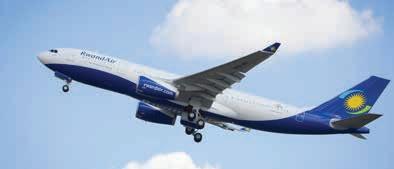
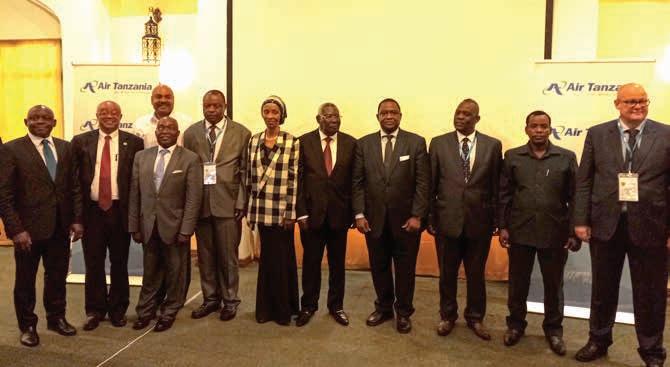
Les acteurs de l’aviation convergent à Zanzibar pour la 7ème convention des parties prenantes de l’aviation
Distinguished guests with the guest of honour His Excellency Seif Ali Iddi (centre), the 2nd Vice President of the Revolutionary Government of Zanzibar, following the conclusion of the opening ceremony. Les invités de marque avec l'invité d'honneur Son Excellence Ali Seif Iddi (centre), deuxième vice-président du Gouvernement révolutionnaire de Zanzibar, après la cérémonie d'ouverture.
AVIATION STAKEHOLDERS CONVENTION
The African Airlines Association (AFRAA), in partnership with Air Tanzania, held the 7th Aviation Stakeholders Convention from 8-10 April 2018 at the Zanzibar Beach Resort in Zanzibar. The Convention's aim is to foster dialogue between stakeholders in order to build sustainable networks in supply chain management and create a competitive environment for aviation business in the continent. The three-day conference which was convened under the high patronage of the Government of the Revolutionary Republic of Zanzibar, was held under the theme: ‘Harnessing Aviation Opportunities in Africa’. The event was graced by His Excellency Seif Ali Iddi, 2nd Vice President of the Revolutionary Government of Zanzibar, who was the event Guest of Honour.
7th 8-10 April 2018
L'Association des compagnies aériennes africaines (AFRAA), en partenariat avec Air Tanzania, a organisé la 7ème Convention des parties prenantes de l'aviation du 8 au 10 avril 2018 au Zanzibar Beach Resort à Zanzibar. Le but de la Convention était de favoriser le dialogue entre les parties prenantes afin de mettre en place des réseaux durables dans la gestion de la chaîne d'approvisionnement et de créer un environnement compétitif au sein du secteur aérien africain. La conférence qui a duré trois jours était organisée sous le haut patronage du Gouvernement de la République révolutionnaire de Zanzibar, sous le thème: «Exploiter les opportunités de l'aviation en Afrique» L'événement a été honoré de la présence de Son Excellence Ali Seif Iddi, deuxième vice-président du Gouvernement révolutionnaire de Zanzibar, qui en était l'invité d'honneur.
The event had over 350 registered high profile delegates from 43 countries across the world consisting of airlines, Civil Aviation Authorities, airports, Air Navigation Service Providers, ground handlers, regulators, aircra�t/engine manufacturers, component suppliers, service providers in the aviation industry and other aviation stakeholders.
Africa is one of the regions with a huge aviation potential. In Africa, aviation supports $72.5 billion in terms of GDP and 6.8 million jobs. According to IATA, over the next 20-years, air travel is forecast to grow at nearly 6% per year in Africa. Building partnerships for the mutual benefit of the aviation industry is necessary in order to exploit the opportunities in Africa and overcome the huge challenges that abound in the continent.
A successful and viable African aviation industry is achievable, but this requires rigorous e�forts as well as close coordination and collaboration by all stakeholders ranging from Governments, regulatory authorities, airports, air navigation service providers, suppliers of the wide range of aviation products and services and the customers. The event called for stakeholders to collaborate to achieve an integrated, interconnected Africa that is competitive within itself and globally.
Each year, the Convention brings together the suppliers of the whole range of aviation products and services and the potential customers of these products and services at one venue annually for purposes of networking, knowledge exchange, business negotiations and forging of win-win business relationships. “The forum is a platform that facilitates the exploitation of opportunities in the continent by the various stakeholders with the view to ultimately improve the aviation support base in the continent”, said Mr. Abdérahmane Berthé, AFRAA Secretary General.
The Convention was structured to incorporate presentations and panel discussions on trendy subjects in aviation on one hand and on the other, the event provided a platform for networking opportunities, one-to-one appointments and masterclasses facilitated by industry experts. The following masterclasses were staged:
i. The Value of Data: Leveraging Analytics to Grow Your Business by ATPCO: This Master Class provided participants with insights around the value of data and how it can impact the entire commercial side of an airline. the class was facilitated by Ms. Amber Jabeen, ATPCO Consultant/Chief Data Scientist and Mr. David Julias – Head of ATPCO Global Consulting.
ii. New Ways for Airlines to Distribute and Personalise with NDC by Amadeus: The class equipped participants with insights on how to solve technology challenges in areas such as merchandising, dynamic pricing and cloud servicing, which are seen as the heavy machinery in the background which will make NDC and improved retailing a reality. The class was facilitated by Ms. Jennifer Morales, Amadeus Senior Sales Engineer for Airline Distribution.
iii. Best Practices in Aircra�t Fleet Planning by Embraer: This Master Class delivered a summarised module of how airlines in Africa should approach �leet planning from a strategic, commercial, and tactical point of view as the Single African Air Transport Market (SAATM) is implemented. Embraer showcased industry valuable industry frameworks and a brief case study. The class was facilitated by Mr. Gad Wavomba, Sales DirectorMiddle East/Africa.
Discussions and presentations at the event addressed various key concerns of the African aviation industry. The event programme also incorporated scheduled one-to-one appointments sessions which
L'événement a connu la participation de plus de 350 délégués de haut niveau venus de 43 pays, dont des compagnies aériennes, des autorités de l'aviation civile, des aéroports, des fournisseurs de services de navigation aérienne, des fournisseurs de services d'assistance en escale, des organismes de réglementation, des constructeurs d'aéronefs et de moteurs, des fournisseurs de composants, d'autres fournisseurs aéronautiques et divers intervenants du milieu aérien.
L'Afrique est une des régions à fort potentiel aéronautique. En Afrique, l'aviation appuie 72,5 milliards de dollars en termes de PIB et 6,8 millions d'emplois. Selon les prévisions de l'IATA, au cours des 20 prochaines années, la croissance du transport aérien africain sera d'environ 6% par an. Créer des partenariats dans l'intérêt mutuel des acteurs de l'aviation est un impératif pour pouvoir tirer parti des opportunités que présente l'Afrique et surmonter la multitude d'énormes défis du continent.
Un secteur aérien africain prospère et viable est possible mais exige des e�forts rigoureux ainsi qu'une étroite coordination et la collaboration de tous les intervenants, allant des gouvernements aux clients, en passant par des autorités de réglementation, des aéroports, des fournisseurs de services de navigation aérienne, des fournisseurs de la vaste gamme de produits et services de l'aviation. L'événement était une occasion pour lancer un appel en faveur d'une collaboration agissante entre les intervenants afin qu'une Afrique intégrée, interconnectée et compétitive tant au niveau interne qu'à l'international soit une réalité.
Chaque année, la Convention réunit les fournisseurs de l'ensemble des produits et services de l'aviation, et les clients potentiels de ces produits et services en un seul lieu aux fins de créer des liens, d'échanger des connaissances, de négocier des contrats d'a�faires et de nouer des relations d'a�faires gagnant-gagnant. «Ce forum est une plate-forme qui facilite l'exploitation des opportunités disponibles sur le continent par divers intervenants dans le but ultime d'augmenter le nombre de ceux qui accompagnent le transport aérien africain», a déclaré M. Abdérahmane Berthé, secrétaire général de l'AFRAA.
La Convention avait au menu des présentations et des discussions de groupe sur des sujets d'actualité sur l'aviation d'une part, et servait de plate-forme de networking, de rendez-vous individuels et de master classes animées par des experts de l'industrie, d'autre part. Les master classes suivantes ont été organisées:
i. La valeur des données: Tirer parti de l'analytique pour développer votre entreprise, par ATPCO: Cette master class a donné aux participants un aperçu de la valeur des données et leur impact potentiel sur l'aspect commercial d'une compagnie aérienne dans son ensemble. La classe était animée par Mme Amber Jabeen, consultante/directrice scientifique chargée des données à ATPCO et M. David Julias - directeur d'ATPCO Global Consulting.
ii. Nouveaux moyens de distribution et de personnalisation pour les compagnies aériennes grâce au programme NDC, par Amadeus: Cette classe a permis aux participants de comprendre la manière de relever les défis technologiques dans des domaines tels que le marchandisage, la tarification dynamique et le cloud servicing, considérés comme la machinerie lourde à l'arrière-plan qui rendront le programme NDC et l'amélioration de la vente au détail une réalité. La classe était animée par Mme Jennifer Morales, Senior Sales Engineer for Airline Distribution chez Amadeus.
iii. Les meilleures pratiques en matière de planification de la �lotte, par Embraer: Cette master class a présenté un module résumé sur la manière dont les compagnies aériennes africaines devraient aborder la planification de la �lotte d'un point de vue stratégique, commercial et tactique, au moment où le marché unique africain du transport aérien (SAATM) est mis en marche. Embraer a présenté les cadres de l'industrie utiles et une brève étude de cas. La classe a été animée par M. Gad Wavomba, Directeur des ventes - Moyen-Orient/ Afrique.
provided an opportunity for delegates to hold exclusive meetings with airlines, selected airports, Civil Aviation Authorities, AFRAA Secretariat and IATA.
The Convention also provided an outstanding brand visibility and business opportunity for industry partners and suppliers of equipment, components, solutions and services. The proud event sponsors include: Air Tanzania, Air Tra�fic Navigation Services (ATNS), Bombardier, Kenya Civil Aviation Authority (KCAA), Oil Energy (Lake Aviation), National Aviation Services (NAS), Puma Energy Tanzania, Sabre Airline Solutions, SITA and Tanzania Civil Aviation Authority (TCAA).
There was an exhibition of products, solutions and services by aviation suppliers in di�ferent categories. Suppliers and/or service providers benefited from the outstanding visibility, networking and direct sales opportunities by displaying their products and interacting with delegates at the conference. The exhibitors include: Accelya, AEG Fuels, African Aerospace, Air Tanzania, Air Tra�fic Navigation Services (ATNS), AVIANET, East African School of Aviation, Ethiopian Airlines, HADID International Services, International Flight Support – IFS, Kenya Airways, National Aviation Services (NAS), National Institute of Transport, Oil Energy Co. Ltd, Puma Energy, SAA Technical, Sabre Airline Solutions, SITA, Tanzania Airports Authority, Tanzania Civil Aviation Authority, TCR, Weathernews Inc, Wirecard Technologies Gmbh and Zanzibar Airports Authority.
AFRAA wishes to thank the Government of the Revolutionary Republic of Zanzibar, Air Tanzania, the Government of the United Republic of Tanzania, the Civil Aviation Authority of Tanzania and all sponsors for their kind support in staging the Convention.
AFRAA looks forward to hosting a memorable event in 2019 at a venue which will be announced in due course.
Les présentations et les discussions qui ont marqué l'événement ont abordé divers enjeux majeurs du secteur aéronautique africain. Au programme de la manifestation figuraient également des tête-à-tête qui ont o�fert aux délégués des occasions de rencontrer des compagnies aériennes, des aéroports sélectionnés, des autorités de l'aviation civile, le secrétariat de l'AFRAA et l'IATA.
La Convention a également donné une excellente visibilité aux marques et des opportunités d'a�faires aux partenaires de l'industrie et aux fournisseurs de matériel, de composants, de solutions et de services. Les fiers sponsors de l'événement sont les suivants: Air Tanzania, Air Tra�fic Navigation Services (ATNS), Bombardier, Kenya Civil Aviation Authority (KCAA), Oil Energy (Lake Aviation), National Aviation Services (NAS), Puma Energy Tanzania, Sabre Airline Solutions, SITA et Tanzania Civil Aviation Authority (TCAA). Les fournisseurs et/ou prestataires de services dans di�férentes catégories ont exposé leurs produits, solutions et services. Ils ont profité des opportunités exceptionnelles o�fertes de visibilité, de réseautage et de ventes directes en présentant leurs produits et en échangeant avec les délégués à la conférence. Les exposants étaient: Accelya, AEG Fuels, African Aerospace, Air Tanzania, Air Tra�fic Navigation Services (ATNS), AVIANET, East African School of Aviation, Ethiopian Airlines, HADID International Services, International Flight Support – IFS, Kenya Airways, National Aviation Services (NAS), National Institute of Transport, Oil Energy Co. Ltd, Puma Energy, SAA Technical, Sabre Airline Solutions, SITA, Tanzania Airports Authority, Tanzania Civil Aviation Authority, TCR, Weathernews Inc, Wirecard Technologies Gmbh et Zanzibar Airports Authority.
L'AFRAA tient à remercier le Gouvernement de la République révolutionnaire de Zanzibar, Air Tanzania, le Gouvernement de la République-Unie de Tanzanie, l'autorité de l'aviation civile de Tanzanie et tous les sponsors pour leur soutien à l'organisation de la Convention. L'AFRAA se réjouit à l'idée d'organiser un événement mémorable en 2019, en un lieu qui sera annoncé en temps opportun.
Well prepared Convention / Convention bien préparée
Dr. Ronald Turyamubona, East African Civil Aviation Academy
Well organized / Bien organisé Eng. August B. Kowero, Fastjet Airline
Had good opportunity to interact with other stakeholders / J'ai eu une bonne opportunité d'interagir avec d'autres parties prenantes
Khadija Adnan, Zanclick Travel and Tours
Embraer master class: Excellent presentation and well facilitated session / Excellente présentation et session bien animée
Kevin Evans, Rolls Royce
Amadeus master class were fantastic / Amadeus master class était fantastique
Jama Mohamed, Jubba Airways
ATPCO master class: Data is everything so in future you should select this topic / Les données sont essentielles. A l'avenir, vous devrez retenir ce sujet
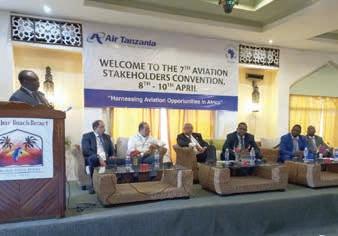
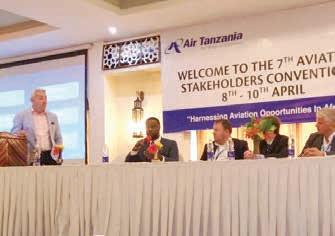

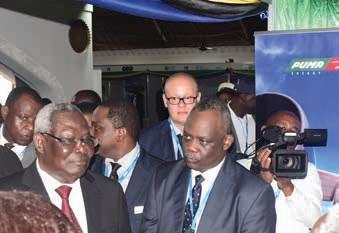
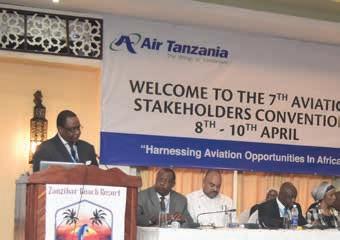
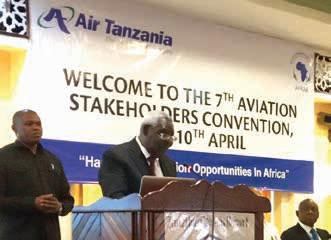

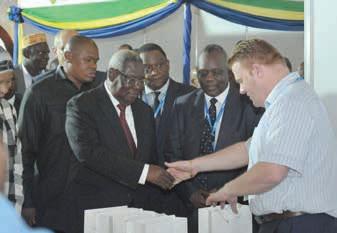
Conference sessions
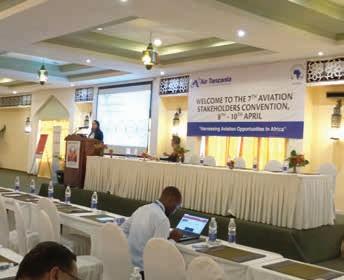
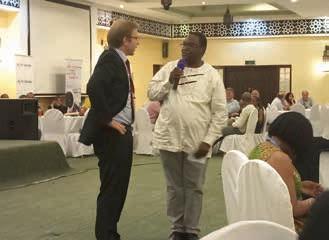


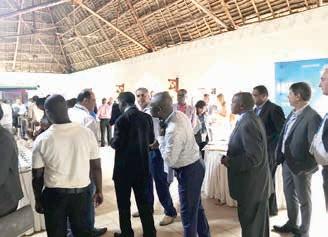
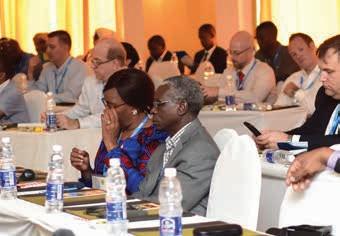

Master classes
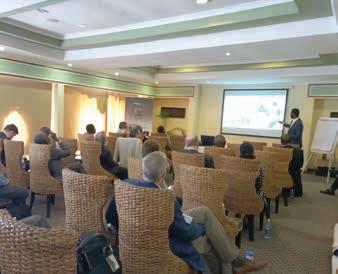
AFRAA Secretary General, Mr. Abdérahmane Berthé (2nd right), IATA DG & CEO, Mr. Alexandre De Juniac (2nd le�t) at the IATA Center in Geneva in the presence of IATA VP Africa, Mr. Raphael Kuuchi and AFRAA Director Commercial Corporate & Industry A�fairs, Dr. Koussai Mrabet.
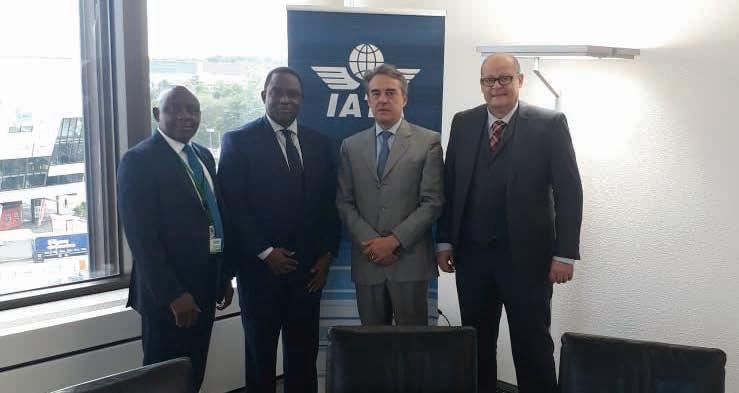
M. Abdérahmane Berthé, SG de l'AFRAA (2ème à droite), M. Alexandre De Juniac, DG de l'IATA (2ème à gauche) au IATA Center, à Genève en présence de M. Raphael Kuuchi, VP IATA pour l'Afrique et Dr. Koussai Mrabet, directeur A�faires commerciales, Services généraux et Relations avec l'industrie a l'AFRAA.
Mr. Abderahmane Berthé, AFRAA Secretary General paid a business visit to Mr. Alexandre De Juniac IATA DG & CEO at the IATA Center in Geneva in the presence of IATA VP Africa Mr. Raphael Kuuchi and AFRAA Director Commercial Corporate & Industry A�fairs, Dr. Koussai Mrabet. This meeting followed the AFRAA-IATA leadership teams meeting which took place in Nairobi, Kenya, at the AFRAA headquarters on 22 March 2018, to review the mutual objectives and action plan for 2018 for both Associations.
AFRAA Secretary General and IATA DG & CEO discussed the focus areas under the new AFRAA Action Plan, developments in the African Air Transport Market, the operationalization of the single African air transport market (SAATM), capacity building, safety, infrastructural development in Africa, reduction of high industry costs, environment and other challenges a�fecting the African continent. The meeting agreed to schedule a visit for IATA DG to meet African airlines CEOs in Africa in the course of the year and agreed to sign a Memorandum of Understanding between IATA and AFRAA that will strengthen the collaboration between both associations.
AFRAA and IATA collaborate on a number of industry focus areas with the objective of delivering quality service to their mutual members and the industry as a whole in Africa.
M. Abderahmane Berthé, secrétaire général de l'AFRAA a e�fectué une visite de travail au siège de l'IATA, à Genève, où il a rencontré M. Alexandre de Juniac, directeur général de l'IATA, en présence M. Raphael Kuuchi, vice-président de l'IATA pour l'Afrique et de M. Koussai Mrabet, directeur des a�faires commerciales, services généraux et relations avec l'industrie de l'AFRAA Cette rencontre faisait suite à réunion des équipes AFRAA et IATA qui a eu lieu au siège de l'AFRAA à Nairobi, au Kenya, le 22 mars 2018 pour évoquer les objectifs et le plan d'action communs des deux associations pour 2018.
Les deux hommes ont abordé les grands axes du nouveau plan d'action de l'AFRAA, les développements intervenus dans le marché du transport aérien africain, la mise en œuvre du Marché unique du transport aérien africain (SAATM), le renforcement des capacités, la sécurité aérienne, le développement des infrastructures en Afrique, la réduction des coûts élevés de l'industrie, l'environnement et d'autres défis qu'a�fronte le continent africain. Ils sont convenus de programmer une visite du DG IATA en Afrique pour rencontrer les directeurs généraux des compagnies aériennes
au cours de l'année et de signer un protocole d'accord entre l'IATA et l'AFRAA pour renforcer les liens de collaboration
associations. L'AFRAA
prioritaires de l'industrie en vue de proposer des services de qualité à leurs membres communs et au secteur aérien africain dans son ensemble.

The AFRAA Ground Handling Steering Committee held a meeting on 7 March 2018 at the Kenya Airways Pride Centre in Nairobi –Kenya to review its objectives and set the action plan for 2018. The Committee targeted the stations for joint lobbying and joint procurement of ground handling services for 2018. The action plan also covers activities on safety, capacity building, standardisation of airline operations and other areas of collaboration among members to realise synergies. The meeting was attended by 14 participants representing 8 airlines.
Le Comité de pilotage assistance en escale de l'AFRAA a tenu une réunion le 7 mars 2018 au Kenya Airways Pride Centre à Nairobi pour examiner les progrès accomplis vers la réalisation de ses objectifs et définir le plan d'action pour 2018. Le Comité a arrêté la liste des aéroports visés par le programme de lobbying commun et par l'acquisition groupée de services d'assistance en escale pour 2018. Le plan d'action comprend également des activités relatives à la sécurité, au renforcement des capacités, à la standardisation des opérations aériennes et à d'autres domaines de collaboration entre les membres pour créer des synergies. La réunion a rassemblé 14 participants représentant 8 compagnies aériennes.
AFRAA Workshops/Seminars January – April 2018
i) IATA Dangerous Goods Workshop – 29 January 2018 at the AFRAA headquarters
AFRAA hosted an IATA Dangerous Goods Workshop on 29 January 2018 at the AFRAA headquarters. The Workshop highlighted the significant changes incorporated in the regulations of handling dangerous goods. The forum also provided a platform for participants to deliberate challenges encountered when handling the cargo classified as dangerous goods. The workshop attracted 29 participants from various airlines, ground handlers and freight companies.
ii) Weight and Balance training – March
In the month of March, AFRAA conducted training for Air Botswana in the area of Weight and Balance; Refresher training was on 12 – 14 & 15 – 17 March and Initial training on 19 – 23 March 2018 at their premises in Gaborone. Air Botswana personnel were equipped with skills on how to properly load luggage and document it in line with the best standard practices.
iii) IATA Resolution 753 Workshop on Baggage Tracking –March
As part of industry campaigns, AFRAA in collaboration with IATA held a workshop on Baggage Tracking on 8 March 2018. The objective of the workshop was to increase awareness among sta�f in charge of baggage handling and to provide them with some tools regarding the implementation plan and available options they have to implement this resolution. In a lively and engaging manner,
Ateliers/séminaires AFRAA janvier – avril 2018
i) Atelier IATA sur les marchandises dangereuses – 29 janvier 2018 au siège de l'AFRAA
L'AFRAA a organisé un atelier IATA sur les marchandises dangereuses le 29 janvier 2018 au siège de l'AFRAA. L'atelier a mis en lumière les changements significatifs introduits dans le règlement relatif au transport des marchandises dangereuses. Le forum a été également pour les participants une plate-forme d'échange sur des problèmes rencontrés dans le transport du fret classé comme marchandises dangereuses. L'atelier a réuni 29 participants provenant de di�férentes compagnies aériennes, sociétés d'assistance en escale et sociétés de transport de fret.
ii) Formation aux techniques de masse et centrage – mars
Au cours du mois de mars, l'AFRAA a organisé une formation pour le compte d'Air Botswana dans le domaine de masse et centrage. Un cours de recyclage dans ce domaine a été organisé du 12 au 14 mars et du 15 au 17 mars, et une formation initiale et du 19 au 23 mars 2018 dans les locaux de la compagnie à Gaborone. Le personnel d'Air Botswana a été formé aux techniques correctes de chargement des bagages et de documentation de l'opération conformément aux meilleures pratiques standards.
iii) Atelier sur la résolution 753 de l'IATA relative au suivi des bagages – mars
Dans le cadre des campagnes de l'industrie, l'AFRAA en collaboration avec l'IATA a organisé un atelier sur le suivi des bagages le 8 mars 2018. L'atelier avait pour objectif de sensibiliser davantage les personnels chargés du traitement des bagages pour les doter de certains outils concernant le plan de mise en œuvre et les options à leur portée pour mettre en application cette résolution. Dans un style dynamique et interactif, les participants ont appris l'historique et les jalons du processus de conformité à la Résolution, les spécificités régionales, les problèmes courants rencontrés lors de la mise
the workshop took the participants through the background and milestones of compliance with the Resolution, regional specificities, common issues being experienced on implementation and possible solutions for the challenges as well as methodology on change of custody for interline connections. A total of 104 participants attended the workshop comprising of airlines, ground service providers, solution providers, airports, AFRAA, IATA and ICAO.
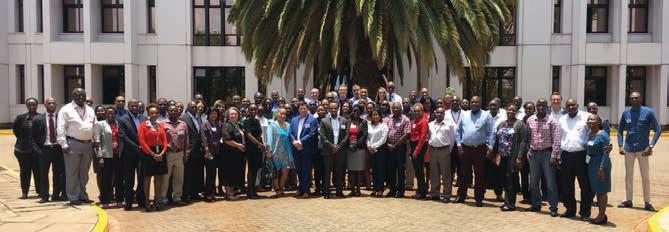
IATA Resolution 753 on baggage tracking was approved by the Joint Passenger Services Conference (JPSC) in 2013. The Resolution requires IATA members to maintain an accurate inventory of baggage by monitoring the acquisition and delivery of baggage. The Resolution stipulates that members must be able to demonstrate delivery of baggage when custody changes, demonstrate acquisition of baggage when custody changes, provide an inventory of bags on departure of a �light and be capable of exchanging these events with other airlines as needed.
Resolution 753 on baggage tracking is a means of driving improvement for individual carriers and within the baggage operations of the industry as a whole. The full benefits of baggage tracking will be realized when tracking data is collected and used. In the rare cases when a bag does not arrive with the passenger there will be much more information available to facilitate a quicker reunion. And the benefits don't stop there. Tracking bags will also reduce fraud, enable proactive reporting, speed up aircra�t readiness for departure and facilitate the automation of baggage processes.
The following courses will be hosted at the AFRAA headquarters. For registration and/or more information, please contact AFRAA Training Coordinator, Ms. Elin Bukhala: ebukhala@afraa.org
en œuvre et les solutions possibles pour les défis ainsi que sur la méthodologie applicable au changement de garde des bagages lors des connexions interline. Un total de 104 participants ont assisté à l'atelier dont des compagnies aériennes, des fournisseurs de services d'assistance en escale, des fournisseurs de solutions, des aéroports, l'AFRAA, l'IATA et l'OACI.
La résolution 753 de l'IATA relative au suivi des bagages a été approuvée par la Conférence des services passagers (JPSC) en 2013. La résolution exige que les membres de l'IATA tiennent un inventaire précis des bagages en e�fectuant un suivi de l'acquisition et de la livraison des bagages. La résolution stipule que les compagnies membres doivent être en mesure de démontrer la livraison des bagages enregistrés lors des changements de garde, la preuve de l'acquisition lorsque la garde des bagages change, fournir un inventaire des bagages au départ d'un vol et être capables d'échanger les informations sur ces événements avec d'autres compagnies aériennes si nécessaire.
La Résolution 753 relative au suivi des bagages est un moyen de perfectionner le système de gestion des bagages de chaque transporteur aérien individuellement et d'améliorer les opérations de gestion des bagages au sein de l'industrie du transport des bagages dans son ensemble. Les pleins avantages du suivi des bagages seront réalisés lorsque les données de suivi seront recueillies et utilisées. Dans les rares cas où un bagage n'arrive pas avec le passager, il y aura beaucoup plus d'informations disponibles pour faciliter une réunion plus rapide. Et les avantages ne s'arrêtent pas là. Le suivi des bagages permettra également une réduction des cas de fraude, des reporting proactifs, accélérera la préparation des avions au départ et facilitera l'automatisation des processus des bagages.
Prochains cours en 2018
Les cours suivants seront organisés au siège de l'AFRAA. Pour l'enregistrement et/ou plus d'informations, veuillez communiquer avec la coordonnatrice de la formation à l'AFRAA, Mme Elin Bukhala: ebukhala@afraa.org
The 4th Air Cargo Committee Meeting was held at the Boma hotel in Nairobi, on 15 – 16 March 2018. The meeting discussed matters such as the ratification of MC99, Cooperation among African Airlines with promises to come up with Interline Electronic Ticketing agreements (IETs) and Special Prorate Agreements (SPAs), the engagement of Customs and Civil Aviation Authorities in the committee activities among others. The meeting was shared by Mr. Sanjeev Gadhia, CEO Astral Aviation and TIACA board Member. The meeting was attended by 20 participants from 8 airlines, IATA, ICAO and TIACA.
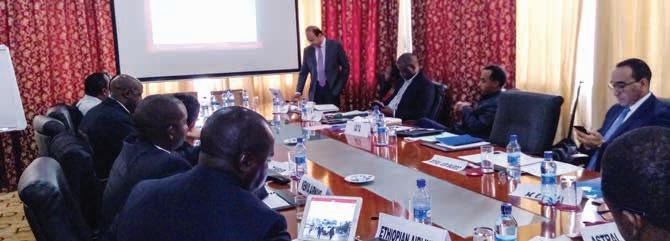
La 4ème réunion du comité du fret aérien s'est tenue à l'hôtel Boma de Nairobi, les 15 et 16 mars 2018. La réunion a examiné des questions telles que la ratification de la Convention de Montréal de 1999, la coopération entre les compagnies aériennes africaines, avec des promesses d'aboutir à des accord de billetterie électronique interline (IET) et des accords spéciaux relatifs aux quotes-parts (SPA), la collaboration avec des autorités de l'aviation civile et des douanes dans les activités du comité, entre autres. La réunion était présidée par M. Sanjeev Gadhia, DG d'Astral Aviation et membre du conseil d'administration de TIACA. La réunion a rassemblé 20 participants de 8 compagnies aériennes, IATA, OACI et TIACA.

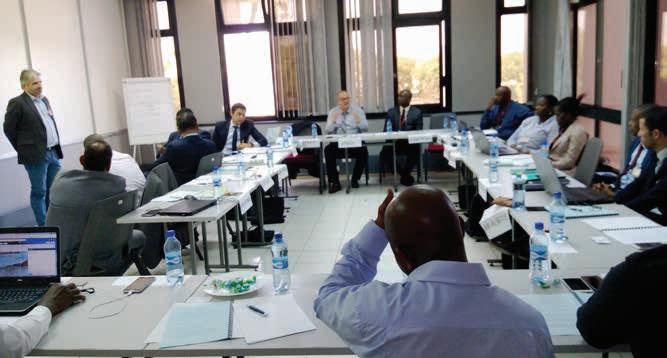
La 9ème réunion du Comité AFRAA de coordination du réseau aérien s’est tenue à Nairobi
The AFRAA Route Network Coordination Committee (RNCC) held its 9th meeting on 26 – 28 February 2018 at the Pride Centre Kenya Airways in Nairobi, Kenya. Among other matters on connectivity and airline network cooperation, the meeting discussed the introduction of Clairity a payment-technology provider supporting the travel industry, to address the issue of accessibility of codeshare, challenges with cross payments for AFRAA ICH and non ICH members within the African continent. The meeting was shared by Mr. Gordon Ribiru, Alliance Manager – Kenya Airways. A total of 18 representatives from 8 Airlines, which included Kenya Airways, PrecisionAir, Air Algérie, Lam Mozambique, Jubba Airways, Royal Air Maroc, EgyptAir and RwandAir attended the meeting. Representatives from Bombardier, Clairity and Milanamos were also in attendance at the meeting.
Following the conclusion of the Route Network Coordination meeting, Bombardier held a seminar on yield management and �leet planning. According to Bombardier, “The performance of a �leet planning team is o�ten measured by its ability to o�fer the lowest cost per seat for a given route. The performance of a revenue management team is o�ten measured by its ability to maximize the revenue per trip for a given route. The type of an airline's network operation drives the type of aircra�t types to be operated which drives back the cost and profit that the airline can generate.”
Le Comité AFRAA de coordination du réseau aérien (RNCC) a tenu sa 9ème réunion du 26 au 28 février 2018 au Pride Centre de Kenya Airways à Nairobi, au Kenya. Parmi les questions abordées sur la connectivité et la coopération en matière de réseau aérien, le Comité a examiné l'introduction de Clairity, un fournisseur de technologie de paiement accompagnant l'industrie du voyage, en vue de s'attaquer à la question d'accessibilité du partage de codes, aux défis relatifs aux paiements croisés pour les membres de l'AFRAA membres et non membres de l'ICH sur le continent africain. La réunion était présidée par M. Gordon Ribiru, Alliance Manager - Kenya Airways. Un total de 18 représentants de 8 compagnies aériennes, à savoir: Kenya Airways, Precisionair, Air Algérie, Lam Mozambique Jubba, Airways, Royal Air Maroc, EgyptAir et RwandAir, ont assisté à la réunion. Des représentants de Bombardier, Clairity et Milanamos ont également pris part à la réunion.
Après la réunion de coordination du réseau, Bombardier a tenu un séminaire sur le yield management et la planification de la �lotte. Selon Bombardier, «La performance d'une équipe de planification de la �lotte est souvent mesurée par sa capacité à o�frir le plus bas coût par siège pour un itinéraire donné. La performance d'une équipe de gestion des revenus est souvent mesurée par sa capacité à maximiser les recettes par voyage pour un itinéraire donné. Le type d‘exploitation du réseau d'un transporteur aérien détermine les types d'aéronefs à exploiter, ce qui entraîne une réduction des coûts et des bénéfices que la compagnie aérienne peut générer.»
The Executive Committee of the African Airlines Association (AFRAA) held its 175th Executive Committee meeting in Nairobi, Kenya on 23 April 2018 to transact normal business of the Association and take critical decisions regarding air transport development on the continent.
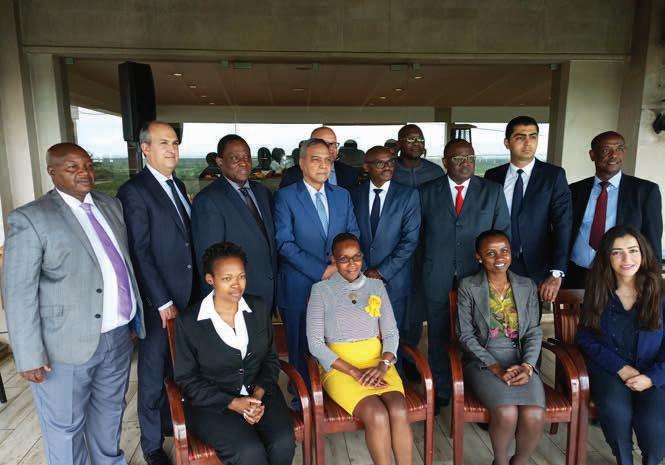
In his report to the Executive Committee, the Secretary General, Mr. Abdérahmane Berthé presented his new action plan for AFRAA which will be the blue print for the Association to achieve a number of strategies that have been evolved. Among others, the Action Plan highlighted the following as priorities of the Association:
• Restructure of the Secretariat
• Industry data sourcing and studies
• Realignment of the Association with the needs of members
• Improvement of Safety and Security in the AFI Region
• Market access and competition
• Reduction of industry costs
• Human capital development
• Strengthening of the continental representation and leadership role of AFRAA
• Enhanced relations with stakeholders
• New revenue streams and joint projects
Among other business, the Committee approved the Action Plan of the Association and set an agenda for a meeting with the Executives
Le Comité exécutif de l'Association des compagnies aériennes africaines (AFRAA) a tenu sa 175ème réunion à Nairobi, au Kenya, le 23 avril 2018 pour délibérer sur des questions administratives de l'Association et prendre des décisions importantes concernant le développement du transport aérien sur le continent.
Dans son rapport au Comité exécutif, le Secrétaire général, M. Abdérahmane Berthé a présenté son nouveau plan d'action qui fixe les priorités stratégiques de l'Association. Le Plan d'action décline, entre autres, les priorités ci-après:
• Restructuration du Secrétariat
• Acquisition de données et études sur l'industrie
• Alignement de l'Association sur les besoins des membres
• Amélioration de la sécurité et de la sureté dans la région AFI
• Accès au marché et concurrence
• Réduction des charges de l'industrie
• Développement du capital humain
• Renforcement du rôle de représentation et de leadership continental de l'AFRAA
• Renforcement des relations avec les autres parties prenantes
• Création de nouvelles sources de revenus et projets communs
of IATA during the forthcoming Annual General Meeting to be held in Sydney in June 2018.
New Partners
Two air transport-related service providers were approved as partners of AFRAA. They include: Aurora Aviation S.A. and Clairity PTE. The AFRAA Partnership Programme is open to all non-airline industry-related organizations which are interested in the development of air transport in Africa. The aim of the partnership programme is to pool together the much needed additional resources and support from industry related organizations for the development of the industry and sustenance of the activities of the Secretariat, while enabling partners to establish relationships with a comprehensive, e�ficient, knowledgeable and in�luential air transport trade organization for Africa.
The Executive Committee is the body empowered by the General Assembly to oversee the interests of all members of the Association. It meets three times a year to review industry developments, strategize and review the activities of the Secretariat as well as provide the necessary leadership and directions for African air transport. Nine members of the Executive Committee were represented at the meeting. The 11-member Committee is chaired by Mr. Safwat Musallam, Chairman of EgyptAir Holding Company and is composed of Chief Executive O�ficers from the following airlines:
i. EgyptAir (Chairman)
ii. Royal Air Maroc (President)
iii. RwandAir (1st Vice Chairman)
iv. Kenya Airways (2nd Vice Chairman)
v. Air Burkina
vi. Air Zimbabwe
vii. Camair-Co
viii. Congo Airways
ix. Ethiopian Airlines
x. South African Airways
xi. Tunisair
Le Comité a approuvé le Plan d'Action de l'Association et a fixé l'ordre du jour de la réunion avec les responsables de l'IATA qui se tiendra en marge de leur Assemblée générale annuelle prévue à Sydney en juin 2018.
Nouveaux partenaires
Les demandes d'adhésion en qualité de partenaires de l'AFRAA de deux fournisseurs de services liés au transport aérien ont été approuvées. Il s'agit des sociétés ci-après: Aurora Aviation S.A. et Clairity PTE. Le Programme de partenariat de l'AFRAA est ouvert à toutes les entités du secteur aéronautique, qui ne sont pas des transporteurs, intéressées par le développement du transport aérien en Afrique. Le but de ce programme est de mobiliser les ressources supplémentaires et l'appui des organisations de l'industrie en faveur du développement du secteur et du soutien aux activités du Secrétariat, tout en permettant aux partenaires de nouer des relations privilégiées avec un organisme professionnel du transport aérien africain à base élargie, e�ficace, compétente et in�luente.
Le Comité exécutif est l'organe mandaté par l'Assemblée générale pour veiller aux intérêts de tous les membres de l'Association. Il se réunit trois fois par an pour ré�léchir aux développements intervenus au sein de l'industrie, arrêter des stratégies et examiner les activités du Secrétariat. Il assume un rôle de leadership et fixe les grands axes du secteur aérien africain. Neuf membres du Comité exécutif ont pris part à la réunion. Constitué de 11 membres, le Comité est présidé par M. Safwat Musallam, Président d'EgyptAir Holding Company et il est composé de directeurs généraux des compagnies aériennes suivantes:
i. EgyptAir (Président du Comité exécutif)
ii. Royal Air Maroc (Président de l'Association)
iii. RwandAir (1er Vice-président du Comité exécutif)
iv. Kenya Airways (2e Vice-président du Comité exécutif)
v. Air Burkina
vi. Air Zimbabwe
vii. Camair-Co
viii. Congo Airways
ix. Ethiopian Airlines
x. South African Airways
xi. Tunisair
If you missed a copy of the Quarterly Africa Wings Magazine or would like to subscribe, please send your request to creative@camerapix.co.ke or bmuyanda@afraa.org

RwandAir and Question Co�fee are partnering to create economic opportunities for women in Rwanda RwandAir et Question Coffee en partenariat pour créer des débouchés économiques en faveur des femmes rwandaises
RwandAir and Question Co�fee announced a ground breaking partnership to serve Rwandan specialty co�fee on all of RwandAir �lights with over 2 million cups to be o�fered in the next 2 years. This partnership allows passengers the opportunity to support small holder women farmers and their families in Rwanda.
RwandAir will be connecting the world to locally grown and roasted co�fee. Question Co�fee is a social enterprise funded by Bloomberg Philanthropies and powered by 27,000 women who are now managing their own businesses and supporting their families in Rwanda.

Mr. Chance Ndagano, the then Ag. Chief Executive O�ficer of RwandAir said: “Serving the fresh and wonderfully tasty Rwandan co�fee on our �lights gives us gratification to o�fer to our clients the best, to continue promoting Rwandan products and sustain our community” .
RwandAir et Question Co�fee ont annoncé un partenariat novateur pour servir du café de spécialité rwandaise sur tous les vols RwandAir, soit plus de 2 millions de tasses qui seront servies au cours des deux prochaines années. Ce partenariat o�fre aux passagers la possibilité de soutenir les petites exploitantes agricoles et leurs familles au Rwanda.




RwandAir assurera la liaison entre le monde et le café cultivé et torréfié localement. Question Co�fee est une entreprise sociale financée par Bloomberg Philanthropies et propulsée par 27.000 femmes qui gèrent maintenant leurs propres entreprises et soutiennent leurs familles au Rwanda.
M. Chance Ndagano, qui était encore DG de RwandAir a déclaré que «Servir le café rwandais frais et savoureux sur tous nos vols nous donne le plaisir d'o�frir à nos clients le meilleur, de continuer à promouvoir les produits rwandais et de soutenir notre communauté. » Source: RwandAir

EgyptAir reprend ses vols sur Moscou
EgyptAir announced the resumption of its �lights between Cairo and Moscow e�fective April 2018.EgyptAir is planning to operate 3 weekly �lights on Tuesday, Thursday and Sunday via Boeing 737-800 aircra�t.


EgyptAir a annoncé la reprise de ses vols entre le Caire et Moscou dès avril 2018. EgyptAir prévoit d'exploiter 3 vols par semaine les mardi, jeudi et dimanche avec des Boeing 737-800.
Source: EgyptAir
LAM and fastjet sign MOU to explore wide-ranging commercial cooperation
LAM et fastjet: une vaste coopération commerciale
LAM and fastjet entered into a Memorandum of Understanding to explore long-term commercial cooperation. The Memorandum was signed in LAM headquarters in Maputo. The intent of the memorandum includes wideranging areas of cooperation expected to significantly enhance commercial aviation in the country. The memorandum covers codeshare and interline agreements between the two carriers, optimised network synergies to accommodate same as well as cooperation on other commercial systems, cargo, engineering and maintenance.
LAM chief executive Mr. Pinto said: “The areas of cooperation will not only further strengthen Mozambique's �lag carrier as a regional air-services provider but contribute significantly to initiatives that promote tourism, economic development and trade. This is an exciting and industryleading public-private partnership initiative,” adds Mr. Pinto. “It not only supports Mozambique's greater economic growth objectives in terms of the e�ficient and a�fordable movement of people and goods, but also the notion of a longer-term Whole of State Aviation strategy.”
LAM et fastjet ont conclu un protocole d'accord portant sur une coopération commerciale à long terme. Le protocole a été signé au siège de LAM à Maputo. Il porte sur de vastes domaines de coopération qui devraient améliorer considérablement l'aviation commerciale dans le pays. Sont visés par le protocole, les accords de partage de codes et interline entre les deux transporteurs, les synergies de réseaux optimisées ainsi que la coopération sur d'autres systèmes commerciaux, le fret, l'ingénierie et la maintenance.
M. Pinto, DG de LAM, a déclaré que «les domaines de coopération vont non seulement rehausser la
Ethiopian Airlines launches 3 new �lights to Kisangani, Mbuji Mayi and Nosy-Be
Ethiopian Airlines lance 3 nouveaux vols vers Kisangani, Mbuji Mayi et Nosy-Be
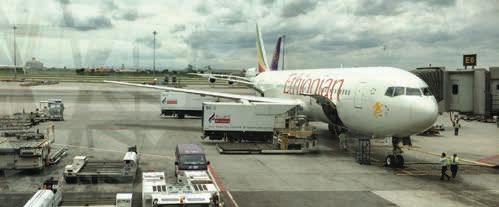
Ethiopian Airlines launched three new �lights to Kisangani and Mbuji Mayi in the Democratic Republic of the Congo (DRC) and Nosy-Be in Madagascar in March 2018.
Speaking at the inaugural ceremony, Group CEO of Ethiopian Airlines, Mr. Tewolde GebreMariam, said: “We are very happy and proud to be a very strong instrument in connecting Africa in line with our motto of the last 70 years – Bringing Africa together and closer to the rest of the world. When we open these three destinations, we may look at only the direct services we are going to operate between Addis and these destinations. But what is more important and may not be visible is that we are connecting these destinations with more than 100 destinations all over the world. Kisangani and Mbuji Mayi will be two additional points to the already three points we �ly in the DRC; so we are now �lying to Kinshasa, Goma, Mbuji Mayi, Kisangani and Lubumbashi.
The beautiful island of Nosy-Be is a popular tourist destination
for Europeans, and since we announced that we are going to connect it with our network in a direct service, the Madagascar Embassy in Addis has been overwhelmed by visa requests. This shows that the trend is changing; nowadays Africans are visiting African friends for tourism which is very encouraging development.”
Ethiopian Airlines a lancé trois nouveaux vols sur Kisangani et Mbuji Mayi en République démocratique du Congo (RDC) et Nosy-Be à Madagascar en mars 2018. Dans son allocution lors de la
cérémonie inaugurale de ce service, le DG d'Ethiopian Airlines, M. Tewolde Gebremariam, a déclaré: «Nous sommes ravis et fiers de notre rôle de premier plan de relier toutes les parties de l'Afrique, fidèles à notre devise des 70 dernières années: Pour l'intégration de l'Afrique et son rapprochement avec le reste du monde. A l'inauguration de ces trois destinations, on serait tenté de voir uniquement les vols directs que nous allons opérer entre Addis et ces destinations. Mais ce qui est plus important et pourrait échapper à l'attention est que nous connectons ces destinations à plus de 100 destinations du monde entier.
stature du transporteur national du Mozambique en tant que fournisseur de services aériens au niveau régional, mais également contribuer de manière significative aux initiatives qui favorisent le tourisme, le développement économique et le commerce. C'est une initiative de partenariat public-privé exceptionnelle et à la pointe de l'industrie,» a ajouté
M. Pinto. «Elle soutient non seulement les objectifs plus larges de croissance économique du Mozambique en termes de mouvements e�ficaces et abordables des personnes et des biens, mais aussi la notion d'une stratégie d'ensemble à long terme de l'aviation d'Etat.» Source: fastjet
Kisangani et Mbuji Mayi seront deux points supplémentaires en plus des trois points que nous desservons en RDC. Sont donc desservis aujourd'hui: Kinshasa, Goma, Kisangani, Mbuji Mayi et Lubumbashi. La belle île de Nosy-Be est une destination touristique populaire pour les Européens, et depuis que nous avons annoncé notre plan de la connecter à notre réseau par un vol direct, l'ambassade de Madagascar à Addis est submergée par des demandes de visas. Cela montre que la tendance change: au jour d'aujourd'hui, les Africains font du tourisme en visitant leurs amis Africains, ce qui est très encourageant.» Source: ET
Cronos Airline launches malabo – Port Harcourt – Accra service
Cronos Airline lance une liaison directe Port Harcourt – Accra

Cronos Airlines launched MalaboPort Harcourt-Accra �lights in a bid to o�fer its passengers more options and strengthen its presence on the West Coast. The Port HarcourtAccra service was introduced one year a�ter the airline entered the Nigerian market with LagosDouala-Malabo �lights. The new service which commenced on 16 March 2018, operates twice weekly on Mondays and Fridays, and comes with special discounted fares across cabins.
According to a statement, business and pleasure travellers will have the opportunity to access the three
oil-rich countries of Equatorial Guinea, Nigeria and Ghana with style and in an uninterrupted manner. The �lights will connect passengers in a direct �light between Malabo, PH and Accra.
Cronos Airlines said with the new PH-Accra �light, it was bringing to bear its upscale service by giving passengers the best of �light services.
Cronos Airlines a inauguré des vols Malabo-Port Harcourt-Accra dans le but d'o�frir plus d'options à ses passagers et de renforcer sa présence sur la côte ouest. Le vol Port Harcourt-
Kenya Airways launches �lights to Mauritius
Kenya Airways lance des vols sur l'Ile Maurice
Accra intervient un an après que la compagnie aérienne soit entrée sur le marché nigérian avec des vols Lagos-Douala-Malabo. Le nouveau service qui a débuté le 16 mars 2018, opère deux fois par semaine les lundis et vendredis, et o�fre des tarifs réduits pour toutes les classes.
Selon un communiqué du transporteur, les voyageurs d'a�faires et les touristes auront la possibilité
d'accéder aux trois pays riches en pétrole, la Guinée équatoriale, le Nigeria et le Ghana, avec style et de manière ininterrompue. Ces vols transporteront les passagers entre Malabo, PH et Accra.
Cronos Airlines a annoncé qu'avec le nouveau vol PH-Accra tout est mis en œuvre pour son service haut de gamme afin de proposer aux passagers le meilleur des vols.
Source: thisdaylive.com
Kenya Airways launched direct �lights to Mauritius as part of its broad strategy to expand its footprint across Africa. The newly launched service will operate four times a week –Monday, Wednesday, Thursday and Saturday. On Monday and Thursday �lights will depart Nairobi at 11:45am while on Wednesday and Saturday �lights will depart Nairobi at 9:50pm.
Kenya Airways already has an existing codeshare agreement on Air Mauritius three weekly �lights to Nairobi. This new service will perfectly complement the existing operations and allow both airlines to o�fer passengers daily service between Nairobi Mauritius with a major beneficiary being the newly
launched �lights to New York. Kenya Airways Group Managing Director and CEO Sebastian Mikosz said: “We are very excited by this new opening that will allow daily connections between two of the most attractive countries in the Region. The direct �light will enable reliable and convenient connectivity and in doing so make Mauritius more accessible to our guests in their bid for economic exchange and particularly tourism.”
The route will be operated by an Embraer E190, with a configuration of 12 Business Class seats and 84 Economy Class seats. Direct operations will commence in June 2018.
Kenya Airways a lancé des vols directs sur l'Ile Maurice dans le cadre de sa vaste stratégie visant à étendre sa présence à travers l'Afrique. Le nouveau service sera assuré 4 fois par semaine: lundi, mercredi, jeudi et samedi. Les lundis et jeudis les vols partiront de Nairobi à 11h45 tandis que les mercredis et samedis, ils partiront de Nairobi à 21h50.
Kenya Airways dispose déjà d'un accord de partage de codes pour trois vols hebdomadaires d'Air Maurice à destination de Nairobi. Ce nouveau service est un complément idéal aux rotations actuelles et permet aux deux compagnies aériennes d'o�frir aux passagers des vols quotidiens entre Nairobi et Maurice, les nouvelles dessertes lancées récemment sur
New York en étant les bénéficiaires principales.
Le DG de Kenya Airways Group, Sebastian Mikosz a déclaré: «Nous sommes très ravis de cette nouvelle ouverture qui permettra des liaisons quotidiennes entre deux des pays les plus attrayants de la région. Le vol direct proposera une connectivité fiable et pratique et rendra ainsi l'Ile Maurice plus accessible à nos clients dans leur quête des échanges économiques et notamment dans le domaine du tourisme.»
La rotation sera assurée par un Embraer E190, avec une configuration de 12 sièges en classe a�faires et 84 sièges en classe économique. Les vols directs commenceront en juin 2018.
Source: Kenya Airways

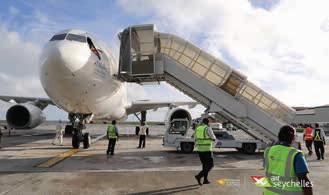
Air Seychelles facilitated an Airbus test �light of an A321LR from Sharjah to Seychelles. The aircra�t arrived in Mahé on Wednesday 28 March at 6 pm, providing a rare chance for aviation enthusiasts to get a glimpse of Airbus’ latest aircra�t before it departed for the French capital in the evening. The A321LR is the newest member of the Airbus A320 family. Remco Althuis, CEO of Air Seychelles, said: “We are delighted to have facilitated this test �light and welcomed the Airbus team to Seychelles. As a proud operator of the Airbus �leet, seeing the latest variant of the A320 family land on our shores has been an exciting moment. Like its predecessors, the A321LR features top-of-theline e�ficiency and performance. It looks set to become another winning aircra�t for Airbus.”
“We are delighted that Air Seychelles is hosting the A321LR
for the first time in the island of Mahé. This aircra�t is about to make a new long-haul �light of over 4000nm, as part of its �light test programme, between the Seychelles and Europe.” said Patrick du Ché SVP Flight and Integration Tests at Airbus.
Airbus successfully completed its maiden A321LR �light on 31 January 2018, from its industrial facility in Hamburg, Germany.
Air Seychelles a facilité un vol d'essai d'un A321LR entre Sharjah et les Seychelles. L'avion est arrivé à Mahé le mercredi 28 mars à 18h00, o�frant une occasion rare aux passionnés de l'aviation de voir de près l'aéronef le plus récent d'Airbus avant son départ pour la capitale française dans la soirée. L'A321LR est le tout nouveau membre de la famille Airbus A320. Remco Althuis, DG d'Air Seychelles, a déclaré: «Nous sommes ravis d'avoir facilité ce vol d'essai et d'avoir accueilli
l'équipe d'Airbus aux Seychelles. En tant que fier exploitant d'une �lotte Airbus, voir la dernière variante de la famille A320 atterrir chez nous a été un moment exaltant. Comme ses prédécesseurs, l'A321LR est d'une e�ficacité et d'une performance exceptionnelles. Il semble être en passe de devenir un autre avion gagnant pour Airbus.»
«Nous sommes ravis qu'Air Seychelles accueille l'A321LR pour la première
fois sur l'île de Mahé. Cet avion est sur le point d'e�fectuer un nouveau vol de longue distance de plus de 4000NM, dans le cadre de son programe de vol d'essai, entre les Seychelles et l'Europe» a déclaré Patrick du Ché SVP Flight and Integration à Airbus.
Le vol inaugural de l'A321LR e�fectué le 31 janvier 2018, à partir des installations industrielles d'Airbus à Hambourg, en Allemagne, a été couronné de succès. Source: Air Seychelles
Boeing and the Lion Air Group celebrated the very first 737 MAX 9 to be delivered. The airplane will go into service with Thai Lion Air, where its added capacity will help the airline launch several international routes.
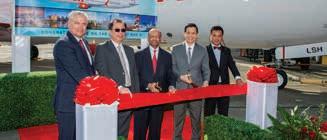
The Lion Air Group is the launch customer for the MAX 9. They were also the first operator to put the MAX 8 into service, and have announced a commitment for 50 MAX 10s. The Group also has an additional 200 737 MAXs on order and is one of the world's largest operators of the 737. Boeing Commercial Airplanes president and CEO Kevin McAllister said “The Lion Air Group is the perfect example of how the 737 MAX family provides a common �leet solution across the single-aisle spectrum. Not only will Lion Air Group benefit from the MAX's range and capacity, they will enjoy the best economics and reliability in the industry.”
The 737 MAX is the fastest-selling airplane in Boeing history, accumulating more than 4,300 orders from 95 customers worldwide. For more information and feature content, visit www.boeing.com/commercial/737max
Boeing et Lion Air Group ont célébré la toute première livraison d'un 737 MAX 9. L'avion entrera en service chez Thai Lion Air, où sa capacité supplémentaire permettra à la compagnie aérienne de lancer plusieurs routes internationales.
Lion Air Group est le client de lancement du MAX 9. Il fut le premier opérateur à mettre le MAX 8 en service, et a annoncé un engagement pour 50 MAX 10. L'un des plus grands opérateurs du 737, le groupe a également commandé 200 737 MAX supplémentaires.
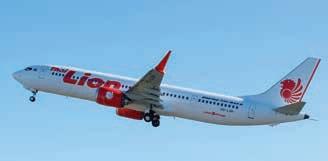
Le PDG de Boeing Commercial Airplanes, Kevin McAllister a déclaré: “Lion Air Group est l'exemple parfait de la manière dont la famille 737 MAX fournit une solution de �lotte commune sur toute la gamme de mono couloirs. Lion Air tirera profit non seulement du rayon d'action et de la capacité du MAX, mais également de ses meilleurs atouts économiques et de sa meilleure fiabilité au sein de l'industrie.”
Le 737 MAX est l'avion le plus vendu dans l'histoire de Boeing, cumulant plus de 4.300 commandes de 95 clients dans le monde entier. Pour plus d'informations, visitez le www.boeing.com/commercial/737max
Source: Boeing

new service propositions for customers.
Rolls-Royce will set out further details of the IntelligentEngine vision over the coming year. Updates will be available via a dedicated webpage: www.rollsroyce.com/intelligentengine
de réagir à l'environnement dans lequel il se trouve sans intervention humaine
• Capable de l'interpréter - apprendre de ses propres expériences et de son réseau de pairs pour adapter son comportement et atteindre de meilleures performances
Rolls-Royce launched its pioneering IntelligentEngine vision at the Singapore Airshow. With more people �lying than ever before and an increasing demand for more e�ficient travel, RollsRoyce has defined a vision for the future of aircra�t power that will help deliver passengers more reliably and more e�ficiently than ever before.
The IntelligentEngine vision is based on a belief that the worlds of product and service have become so closely connected that they are now inseparable. This trend was first identified when Rolls-Royce introduced the market-defining TotalCare® service in the 1990s and, since then, advancements in digital capability have accelerated this change and further blurred the boundary between the two. The coming together of product and service, supercharged by digital technology, o�fers RollsRoyce a wealth of opportunities to improve the way it provides power to its customers.
In addition to designing, testing, and maintaining engines in the digital realm, the IntelligentEngine vision sets out a future where an engine will be increasingly connected, contextually aware and comprehending, helping to deliver greater reliability and e�ficiency:
• Connected – with other engines, its support ecosystem, and with its customer, allowing for regular, two-way �low of information between many parties
• Contextually aware – of its operating context, constraints and the needs of the customer, allowing it to respond to the environment around it without human intervention
• Comprehending – learning from its own experiences and from its network of peers to adjust its behaviour and achieve best performance
Dominic Horwood, Rolls-Royce, Director, Customer and Services
– Civil Aerospace, said: “We are determined to pioneer the power that matters for our customers and our IntelligentEngine vision will allow us to do this. We have the right people, the right skills and the right infrastructure to grasp this opportunity and deliver worldbeating digital insight, helping us to deliver even greater value for our customers.”
The IntelligentEngine vision enables Rolls-Royce to find new ways of pioneering power, whether that is through its engines installed today, through its future UltraFan® engine design, or even through the hybrid-electric concepts of the future.
Rolls-Royce's R2 Data Labs, an acceleration hub for data innovation launched in December 2017, will play a key role in achieving the aims of the IntelligentEngine. Using advanced data analytics, industrial Artificial Intelligence and machine learning techniques, R2 Data Labs develops data applications that unlock design, manufacturing and operational e�ficiencies within Rolls-Royce, and creates
Rolls-Royce a lancé sa vision innovante IntelligentEngine au salon aéronautique de Singapour. Face à une augmentation sans précédent du nombre de voyageurs et une demande accrue de voyages plus e�ficients, RollsRoyce a défini une vision pour l'avenir de la propulsion aéronautique qui permettra de transporter les passagers d'une manière plus fiable et plus e�ficace que jamais auparavant.
La vision IntelligentEngine repose sur la conviction que les mondes de produits et de services sont devenus si étroitement liés qu'ils sont maintenant inséparables. Cette tendance a été reconnue pour la première fois lorsque Rolls-Royce a introduit TotalCare®, un service qui a redéfini le marché dans les années 1990 et, depuis lors, les progrès dans le domaine du numérique ont accéléré ce changement et rendu plus �loue la ligne de démarcation entre les deux.
La rencontre du produit et du service, boostée par la technologie numérique, o�fre à Rolls-Royce une foule de possibilités pour améliorer la façon dont la propulsion aéronautique est assurée auprès de ses clients.
En plus de la conception, l'essai et la maintenance de moteurs dans l'univers digital, la vision IntelligentEngine évoque un avenir où un moteur sera de plus en plus connecté, conscient du contexte et capable de l'interpréter, pour une plus grande fiabilité et e�ficacité:
• Connecté – à d'autres moteurs, son écosystème de soutien, et ses clients, ce qui permet un �lux d'informations
régulier dans les deux sens entre de nombreuses parties Conscient du contexte – de son contexte d'exploitation, des contraintes et des besoins du client, lui permettant
Dominic Horwood, directeur clients et services de Civil Aerospace Rolls-Royce a déclaré: «Nous sommes déterminés à trouver la puissance qui compte pour nos clients et la vision de notre IntelligentEngine nous permettra de le faire. Nous avons les personnes, les compétences et les infrastructures qu'il faut pour saisir cette occasion et o�frir des perspectives numériques supérieures à l'échelle mondiale, ce qui nous permettra d'o�frir encore plus de valeur à nos clients.»
La vision d'IntelligentEngine permet à Rolls-Royce de trouver de nouveaux moyens de propulsion d'avant-garde, que ce soit par ses moteurs installés aujourd'hui, grâce à sa future conception des moteurs UltraFan®, ou même à travers le concept hybrideélectrique de l'avenir.
Le R2 Data Labs de Rolls-Royce, un hub d'accélération de l'innovation en matière de données lancé en décembre 2017 jouera un rôle clé dans la réalisation des objectifs d'IntelligentEngine. En utilisant des analyses de données avancées, l'intelligence artificielle et des techniques d'apprentissage automatique, R2 Data Labs développe des applications de données qui débloquent la conception, la fabrication et l'e�ficacité opérationnelle au sein de Rolls-Royce, et crée de nouvelles propositions de service aux clients. Rolls-Royce fournira plus de amples détails sur l'initiative IntelligentEngine au cours de l'année. Les mises à jour seront disponibles via une page web spéciale: www.rolls-royce.com/ intelligentengine

Amadeus invests in CrowdVision to help airports manage growing passenger volumes Amadeus investit dans CrowdVision pour aider les aéroports à gérer les volumes de passagers en hausse
With the International Air Transport Association (IATA) expecting 7.2 billion passengers to travel in 2035 – a near doubling of the 3.8 billion air travellers in 2016 – passenger volumes show no sign of slowing down. CrowdVision, Amadeus Ventures’ latest investment, is helping airports manage the growth, so travellers can benefit from faster check-ins and shorter security lines.
Suzanna Chiu, The Head of Ventures at Amadeus said: “Together with CrowdVision, we will be able to help airports to better anticipate and respond to traveller �lows for better realtime, planning and investment decisions. We're committed to helping airports improve their operations and performance,
because when airports run smoothly, everyone benefits: airports can get more value out of their retail areas, more �lights can take o�f on time, and travellers enjoy better journeys.”
Amadeus Ventures, the corporate venture arm of Amadeus, invests in start-ups sitting at the crossroads of travel and technology. Amadeus launched this initiative in 2014 and CrowdVision is the latest addition to a portfolio that includes start-ups such as Situm, Avuxi, Betterez, Bluesmart, BookingPal, Flyr and Yapta.

Au moment où l'Association du transport aérien international (IATA) prévoit 7,2 milliards de passagers
en 2035, représentant quasiment le double des 3,8 milliards de voyageurs aériens de 2016, les volumes de passagers ne montrent aucun signe de ralentissement. CrowdVision, l'investissement le plus récent d'Amadeus Ventures, permet aux aéroports de gérer la croissance, afin que les voyageurs puissent bénéficier d'un processus d'enregistrement des passagers plus rapide et de queues de sécurité plus courtes.
Suzanna Chiu, Chef d'entreprises à Amadeus a�firme: «Avec CrowdVision, nous serons en mesure d'aider les aéroports à mieux anticiper et répondre aux �lux des voyageurs pour une meilleure planification et des décisions d'investissement en temps réel. Nous sommes déterminés à aider les aéroports à améliorer leurs opérations
Bombardier Commercial Aircra�t Customer Services wins 2018 Gold Stevie® Award Le Service à la clientèle de Bombardier Avions Commerciaux remporte le Prix Gold Stevie® 2018
et performance, car quand les aéroports fonctionnent bien, tout le monde en bénéficie: les aéroports tirent meilleur profit de leur zones de vente au détail, plus de vols décollent à temps, et les voyageurs ont une meilleure expérience de voyage.»
Amadeus Ventures, la branche d'entreprise corporative d'Amadeus, investit dans des start-ups qui sont à la croisée du tourisme et de la technologie. Amadeus a lancé cette initiative en 2014 et CrowdVision est la dernière addition à un portefeuille qui comprend des start-ups tels que Situm, Avuxi, Betterez, Bluesmart, BookingPal, Flyr et Yapta. Source: Amadeus
Bombardier Commercial Aircra�t's Customer Services team was presented with a Gold Stevie® Award in the category: Customer Service Department of the Year – Airlines, Distribution & Transportation, at the 12th Annual Stevie Awards Gala in Las Vegas, Nevada.

Todd Young, Vice President and General Manager, Customer Services and Q400 Aircra�t Program, Bombardier Commercial Aircra�t said: “O�fering the best experience to our customers is the very foundation of our FlightAdvantage programme. Our dedicated teams are fueled by delivering world-class service and the 2018 Gold Stevie Award recognizes the team's expertise, experience, passion and commitment to provide a customer-first experience every day.”
L'équipe du Service à la clientèle de Bombardier Commercial Aircra�t a reçu le Gold Stevie® Award dans la catégorie: Département Service clients de l'année –Compagnies aériennes, distribution et transport, lors de la 12ème édition annuelle du Gala des Prix Stevie à Las Vegas, dans le Nevada.
Todd Young, vice-président et directeur, Services à la clientèle et Programme Q400 de Bombardier Avions Commerciaaux, a déclaré: «O�frir la meilleure expérience à nos clients est le fondement même de notre programme FlightAdvantage. Nos équipes dévouées sont animées d'une volonte de fournir des services de classe internationale et le Gold Stevie Award 2018 reconnaît l'expertise et l'expérience de l'équipe, sa passion et son engagement en vue de proposer chaque jour une expérience axée sur le client.» Source: Bombardier
GE Aviation and AirAsia sign agreement for digital solutions across airline �leet GE Aviation et AirAsia signent un accord pour des solutions numériques pour l'ensemble de la �lotte de la compagnie aérienne
GE Aviation and AirAsia signed a four-year agreement for GE to provide the electronic Flight Operations Quality Assurance (eFOQA) and the FlightPulse pilot application for AirAsia's �leet of about 355 A320 and A330 aircra�t and 4,000 pilots.
Andrew Coleman, Chief Commercial O�ficer for GE Aviation said: “FlightPulse is a mobile �light data application that provides pilots with data and analytics to help them �ly more e�ficiently and help reduce carbon emissions. The app puts valuable information that was previously only available at a �leet wide level or used by analysts directly into the hands of the people �lying the aircra�t – the pilots.”
FlightPulse provides pilots with �light data in a very visual way, allowing them to see firsthand the amount of fuel used at di�ferent
stages of a �light and how they can help to reduce carbon emissions.
GE Aviation et AirAsia ont signé un accord de quatre ans pour fournir l'assurance de la qualité des opérations aériennes par moyens électroniques (eFOQA) et l'application pilote FlightPulse pour la �lotte d'AirAsia d'environ 355 avions A320 et A330, et 4.000 pilotes.
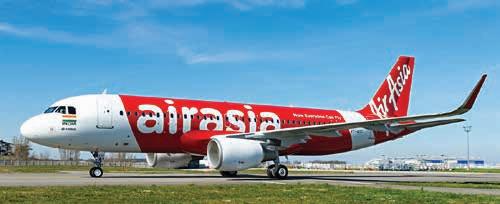
Andrew Coleman, directeur commercial de GE Aviation a déclaré: «FlightPulse est une application mobile qui fournit aux pilotes des données et analyses de vol pour les aider à piloter d'une manière plus e�ficace et contribuer à réduire les émissions de carbone. L'appli met des informations précieuses qui n'étaient auparavant disponibles qu'à l'échelle de toute
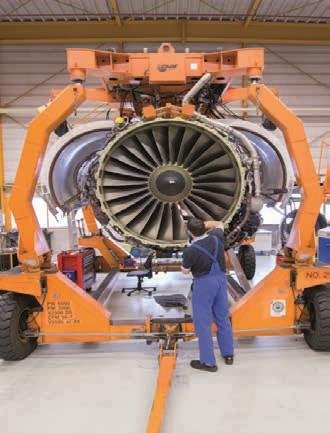
Un contrat de maintenance du moteur CFM56 entre MTU Maintenance et Tunisair Technics
MTU Maintenance and Tunisair Technics signed a five year maintenance agreement for the airline's CFM56-5B/-7B engines. The contract covers maintenance, repair and overhaul, on-site services and spare engine leasing support.
Tunisair is the Tunisian �lag carrier and Tunisair Technics is part of Group Tunisair. The airline operates a �leet of 29 aircra�t and routes within the Middle East, North Africa, West Africa and Europe, as well as an international route to Canada. Tunisair was founded in 1948 and operates out of Tunis Carthage International Airport.
MTU Maintenance has been overhauling CFM56 engines for over 18 years. The company performs around 175 shop visits per year on the engine family at its locations in Hannover (Germany), Vancouver (Canada) and Zhuhai (China). MTU Maintenance is the independent services provider for the popular – 3/-5B/-7B variants and had a market share of 9% in 2017.
la �lotte ou utilisées par les analystes, directement entre les mains des personnes aux commandes de l'appareil - les pilotes.»
FlightPulse donne aux pilotes l'accès aux données de vol d'une façon très visuelle, ce qui leur permet de voir directement la quantité de carburant utilisé à di�férentes étapes d'un vol et comment ils peuvent aider à réduire les émissions de carbone.
Source: GE Aviation
MTU Maintenance et Tunisair Technics signent un contrat de maintenance de cinq ans portant sur les moteurs CFM56-5B et -7B de la compagnie tunisienne. Le contrat couvre l'entretien, la réparation et la révision, les services sur place et le soutien au leasing de moteurs de rechange.
Tunisair est la compagnie nationale tunisienne et Tunisair Technics fait partie du Groupe Tunisair. La compagnie aérienne exploite une �lotte de 29 appareils et des liaisons au MoyenOrient, en Afrique du Nord, en Afrique de l'Ouest et en Europe, ainsi qu'une ligne internationale vers le Canada. Tunisair a été fondée en 1948 et opère à partir de l'Aéroport International de Tunis Carthage.
MTU Maintenance e�fectue la remise en état de moteurs CFM56 depuis plus de 18 ans. La société e�fectue environ 175 visites en atelier par an sur cette famille de moteurs sur ses sites à Hanovre (Allemagne), Vancouver (Canada) et Zhuhai (Chine). MTU Maintenance est le fournisseur de services indépendants pour les versions populaires – 3/-5B/-7B et avait une part de marché de 9% en 2017.
Source: MTU
First Embraer E190-E2 delivered: MTU Aero Engines contributes GTF technologies Livraison du premier Embraer E190-E2: MTU Aero Engines apporte les technologies GTF
For Widerøe, the E-Jet ushers in a new era; for so far, its �leet has consisted of Dash 8 turboprop aircra�t. The carrier has placed firm orders for three E2s and has taken purchase rights for up to another 12 of the aircra�t. The E190-E2 will not be the only second-generation E-Jet. A stretched version – the E195-E2 – will become the second member of the family, and a shorter variant – the E175-E2 – will be added to the �leet in 2021. The E175-E2 will be powered by the PW1700G geared turbofan engine, in which MTU has a stake too.
«La mise en service de la génération E2-Jet d'Embraer est un énorme succès pour MTU,» a déclaré le chef du programme Michael Schreyögg. «Avec les moteurs à turbofan à réducteur pour la série C de Bombardier et pour les futurs avions MRJ auxquels s'ajoutent nos o�fres de services CF34 MRO, nous avons maintenant une gamme complète de produits pour servir l'ensemble de la �lotte de jets régionaux.»
Embraer delivered the first E-Jet E190-E2 to its launch customer, Norwegian regional carrier Widerøe. The aircra�t has technologies made by MTU Aero Engines on board: MTU has a programme share of 17 percent in the PW1900G geared turbofan engine, contributing technologies in which it excels – the unique high-speed low-pressure turbine and the forward four stages of the high-pressure compressor.
“Entry into service of Embraer's E2-Jet generation is a huge success for MTU,” says MTU Chief Program O�ficer Michael Schreyögg. “Together with the geared turbofan engines for the Bombardier C Series and for the future MRJ aircra�t, plus our CF34 MRO service o�ferings, we now have a complete range of products to serve the entire �leet of regional jets.”
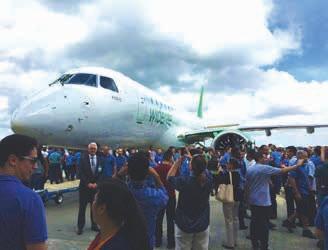
SITA has been named Service Provider of the Year in the prestigious annual Air Transport Industry Awards held in Dubai. The winners are voted for by the readers of Air Transport News and a jury of international aviation experts, chaired by Henrik Hololei, Director-General for Mobility and Transport at the European Commission.
The Service Provider of the Year award was given to SITA in recognition of its role in providing IT and communication solutions globally to the air transport industry. SITA's unique role as the community provider – being owned by the industry –means it has an unprecedented understanding of the industry's
requirements, combined with dedicated teams around the world which deliver services needed to keep people �lying.
Barbara Dalibard, CEO, SITA said: “Being named as Service Provider of the Year at the 2018 Air Transport Awards is a significant achievement and a strong validation of our unwavering collaboration and contribution to the air transport community. To be selected by our industry peers for this award is testament that our continued focus on delivering real value to the community is both justified and valued by the industry.”
The Air Transport Industry Awards were presented at a ceremony at the Burj al Arab hotel in Dubai.
Embraer a livré le premier E-Jet E190-E2 à Widerøe, transporteur régional norvégien, son client de lancement. L'appareil est doté de technologies réalisées par MTU Aero Engines: MTU détient 17 pour cent d'actions du programme du turboréacteur PW1900G, apportant des technologies dans lesquelles il excelle – l'unique turbine haut-débit, basse-pression et la transmission en quatre étapes du compresseur haute pression.
Pour Widerøe, l'E-Jet inaugure une nouvelle ère, car jusqu'à présent sa �lotte était composée d'avions à turbopropulseurs Dash 8. Le transporteur a passé une commande ferme pour trois E2 et détient des droits d'achat sur 12 autres avions. L'E190-E2 ne sera pas le seul E-Jet deuxième génération. Une version allongée - l'E195-E2 - deviendra le deuxième membre de la famille, et une variante plus courte – l'E175-E2 - sera ajoutée à la �lotte en 2021. L'E175-E2 sera propulsé par le turboréacteur PW1700G, auquel MTU participe également.
SITA a été nommée Prestataire de services de l'année lors des prestigieux Prix annuels de l'industrie du transport aérien tenus à Dubaï. Les gagnants sont votés par les lecteurs d’ Air Transport News et un jury d'experts de l'aviation internationale, présidé par Henrik Hololei, directeur général Mobilité et transports à la Commission européenne.
Le prix Service Provider of the Year a été décerné à SITA en reconnaissance de son rôle dans la fourniture de solutions informatiques et de communication au niveau mondial pour l'industrie du transport aérien. L'unique rôle de SITA – détenue par l'industrie – en sa qualité de fournisseur communautaire signifie qu'elle comprend de façon inégalée les besoins de l'industrie, avec des
équipes dévouées du monde entier qui fournissent des services nécessaires pour faciliter les voyages aériens.
Barbara Dalibard, directeur général, SITA a déclaré: «Remporter le titre de fournisseur de l'année lors des prix Air Transport Industry de 2018 est une réalisation importante et une forte validation de notre collaboration et contribution à la communauté du transport aérien. Être sélectionné par nos pairs du secteur pour ce prix est la preuve que notre accent constant sur la fourniture de solutions d'une valeur réelle à la communauté est à la fois justifié et apprécié par l'industrie.»
Les prix Air Transport Industry ont été remis lors d'une cérémonie qui s'est déroulée à l'hôtel Burj al Arab à Dubaï.
Source: SITA
E�fective 1st March 2018, The Board of Directors has appointed Teddy Kassa as the new Chief Executive O�ficer at American General Supplies. Teddy has been serving in many di�ferent roles at AGS, the last position being that of Senior Vice President of Sales and Purchasing. Also, e�fective immediately, Yem Maru, AGS’ Senior Vice President of Corporate Services has been appointed by the AGS Board to the position of Chief Operating O�ficer. In her new capacity, Yem will be responsible for the daily operation of the company and assist Teddy in the leadership role of American General Supplies, Inc. Kassa Maru will maintain his position as Chairman of the Board .
As a proud member of the African Airlines Association (AFRAA), CellPoint Mobile applauds the launch of the Single African Air Transport Market (SAATM) by 23 African States in January 2018. Liberalization policies like SAATM – as with the EU-US Open Skies Agreement and ASEAN Open Skies before it – provide immense benefits to airlines and other companies in the travel sector, and to consumers and travellers in the region. At a fundamental level, they make travel easier, which is precisely what CellPoint Mobile endeavors to achieve through mobile-first solutions.
Statistics bear out the potential benefits of this initiative. To raise awareness of the potential benefits of SAATM, AFCAC and IATA in 2015 commissioned a study on benefits of full air transport liberalisation between 12 African countries which found that complete air connectivity across these countries would add $1.3 billion to GDP, create over 155,000 new jobs, increase direct �lights by 75%, and give approximately 5 million passengers greater access to air travel. The set of countries included in this study is not an exact representation of the countries participating in SAATM, but the economic and social impacts should be comparable. The ultimate goal for SAATM, according to the African Union's
working document on the initiative, is for the single liberalized market to evolve into a broader common aviation area spanning the entire AU, including:
• The abolition of bilateral air service agreements between member states for intra-Africa tra�fic;
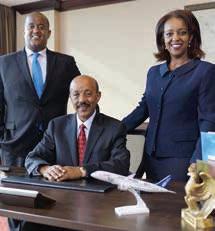
• Facilitation of trade in services and free movement of goods;
• Enhanced cross-border investment in the industry;
• E�fective safety, security and technical standards;
• Harmonised competition regulation;
• Revised visa requirements to enable the free movement of Africans in the continent. CellPoint Mobile supports these goals and stands ready to help African airlines optimise the opportunities presented by SAATM and the overall liberalisation of air transport on the continent.
To learn about how CellPoint Mobile's solutions can help African airlines achieve their operational goals in the new SAATM environment, contact us at: ciaran@cellpointmobile.com
Fier membre de l'Association des compagnies aériennes africaines (AFRAA), CellPoint mobile salue le lancement par 23 Etats africains du marché unique africain du transport
À compter du 1er mars 2018, le Conseil d'administration a nommé Teddy Kassa au poste de Directeur Général d'American General Supplies. Teddy a occupé di�férents postes de responsabilité au sein d'AGS, le dernier en date étant celui de Senior Vice President of Sales and Purchasing. De même, avec e�fet immédiat, Yem Maru, Senior Vice President of Corporate Services d'AGS a été nommée par le Conseil d'administration au poste de Chief Operating O�ficer. Dans le cadre de ses nouvelles fonctions, Yem sera responsable de la gestion quotidienne de l'entreprise et assistera Teddy dans son rôle de dirigeant d'American General Supplies, Inc. Kassa Maru conservera son poste de président du Conseil d'administration.Source AGS
aérien (SAATM) en janvier 2018. Les politiques de libéralisation comme le SAATM - à l'instar de l'accord « ciel ouvert » entre l'UE et les États-Unis et l'accord « ciel ouvert » ANASE qui l'a précédé – fournissent d'immenses avantages aux compagnies aériennes et à d'autres entreprises du secteur du transport, ainsi qu'aux consommateurs et aux voyageurs de la région. À un niveau fondamental, ils facilitent les déplacements, ce qui est précisément ce que Mobile CellPoint s'e�force d'atteindre par le biais de solutions mobile-first.
Les statistiques confirment les avantages potentiels de cette initiative. Pour mieux faire connaître les avantages potentiels du SAATM, la CAFAC et l'IATA en 2015 ont commandité une étude sur les avantages de la pleine libéralisation du transport aérien entre 12 pays africains qui a constaté qu'une connectivité aérienne totale à travers ces pays ajouterait 1,3 milliard de dollars au PIB, créerait plus de 155.000 nouveaux emplois, augmenterait le nombre des vols directs de 75%, et donnerait à environ 5 millions de passagers un meilleur accès au transport aérien. L'ensemble des pays concernés par cette étude n'est pas une représentation exacte des pays participant au SAATM, mais les incidences économiques et sociales devraient être comparables.
Le but ultime du SAATM, selon le document de travail de l'Union africaine relatif à l'initiative, est de faire évoluer le marché unique libéralisé en un espace aérien commun plus large regroupant la totalité de l'UA, ainsi que:
• L'abolition des accords bilatéraux relatifs aux services aériens entre les États membres pour le trafic intra-Afrique;
• La facilitation des échanges de services et de la libre circulation des marchandises;
• Le renforcement de l'investissement transfrontalier au sein du secteur;
• Des normes de sécurité, de sureté et techniques e�ficaces;
• Une réglementation harmonisée de la concurrence;
• Une révision des exigences en matière de visas pour permettre la libre circulation des Africains à l'intérieur du continent.
CellPoint Mobile soutient ces objectifs et est prête à accompagner les compagnies aériennes africaines pour maximiser les possibilités o�fertes par le SAATM et l'ensemble de la libéralisation du transport aérien sur le continent. Pour en savoir plus sur la manière dont les solutions de CellPoint Mobile peuvent aider les compagnies aériennes africaines à atteindre leurs objectifs opérationnels dans le nouvel environnement SAATM, contactez-nous à l'adresse
ciaran@cellpointmobile.com
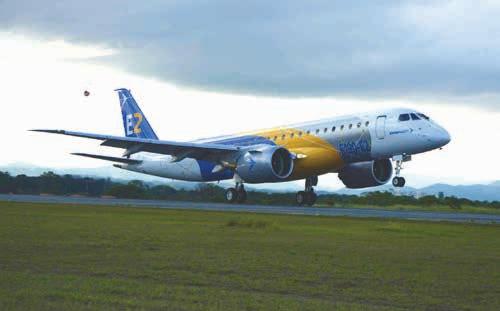
In a ceremony held at the Company's facilities in São José dos Campos, Embraer received Type Certificate for the E190-E2, the first member of the E-Jets E2 family of commercial aircra�t, from the Brazilian Civil Aviation Agency (Agência Nacional de Aviação Civil – ANAC), the FAA (Federal Aviation Administration) and EASA (European Aviation Safety Agency).
John Slattery, President and CEO, Embraer Commercial Aviation said: “Today's certification of the E190-E2 marks a pivotal milestone in the programme. It's reasonable to now anticipate an acceleration of commercial discussions with operators around the globe. Today, many of the campaigns involving the E190-E2 and it's bigger sibling the E195-E2 are with new operators for Embraer – and that's very encouraging as we continue our trajectory towards 100 E-Jets operators around the world.”
Au cours d'une cérémonie tenue dans les locaux de l'entreprise à São José dos Campos, Embraer a reçu de l'Agence de l'Aviation Civile Brésilienne (Agência Nacional de Aviação Civil - ANAC), la FAA (Federal Aviation Administration) et l'AESA (Agence européenne de la sécurité aérienne) un certificat de type pour l'E190-E2, premier membre de
ATR announced its first deal of 2018 which sees the introduction of the ATR -600 series in the US, to be operated by Silver Airways. The airline will introduce 20 ATR -600 aircra�t into its �leet, of which 16 will be ATR 42-600s and four will be ATR 72-600s. This follows a deal between ATR and Nordic Aviation Capital (NAC) for the purchase of 15 ATR -600s, of which 12 will be ATR 42-600s and three will be ATR 72-600s. These aircra�t, along with five from an existing order between ATR and NAC, will be leased to Silver Airways, making them the first operator of ATR -600 series aircra�t in the US.
Christian Scherer, ATR's
Chief Executive O�ficer said: “It is pleasing to celebrate the New Year by announcing a deal that marks ATR's comeback to the United States and we welcome Silver Airways to our �leet of operators. We also extend our congratulations to NAC with whom we can celebrate another deal.
We are excited that passengers in the US will now be able to enjoy �lying in a modern turboprop and experience the comfort of the ATR cabin. With the US having lost some 400 regional routes in the last decade we are confident that Silver Airways’ passengers will certainly appreciate the pleasure of �lying onboard the ATR -600 instead of the alternative of a very long drive!”
la famille des avions commerciaux E-Jets E2.
John Slattery, PDG, Embraer Commercial Aviation, a annoncé: «La certification aujourd'hui du E190-E2 marque un jalon crucial pour le programme. Maintenant on peut raisonnablement s'attendre à une accélération des discussions
commerciales avec les opérateurs à travers le monde. Aujourd'hui, beaucoup de campagnes menées en faveur de l'E190-E2 et son plus grand frère l'E195-E2 se font auprès de nouveaux opérateurs d'Embraer – et c'est très encourageant, car nous continuons notre trajectoire vers la barre des 100 opérateurs d'E-Jets dans le monde entier.» Source: Embraer
ATR a annoncé sa première transaction de 2018 concernant l'introduction de la série ATR-600 aux États-Unis, qui sera exploitée par Silver Airways. La compagnie aérienne va introduire 20 ATR -600 à sa �lotte, dont 16 ATR 42600 et 4 ATR 72-600. Ceci fait suite à un accord entre ATR et Nordic Aviation Capital (NAC) pour l'achat de 15 ATR -600, dont 12 ATR 42-600 et 3 ATR 72600. Ces avions, dont cinq d'un contrat de commande en cours entre ATR et NAC, seront loués à Silver Airways, faisant d'elle le premier exploitant d'ATR-600 aux États-Unis.
Christian Scherer, Directeur général d'ATR, a déclaré: «Ça fait plaisir de célébrer la nouvelle année en annonçant un accord qui marque le grand retour
d'ATR aux Etats-Unis et nous sommes heureux d'accueillir Silver Airways dans notre famille d'opérateurs. Nous adressons également nos félicitations à NAC avec lequel nous célébrons un autre accord. Nous sommes ravis que les passagers aux États-Unis seront maintenant en mesure de faire un voyage agréable dans un turbopropulseur moderne et découvrir le confort de la cabine ATR. Les ÉtatsUnis ayant perdu quelques 400 routes régionales au cours de la dernière décennie, nous sommes convaincus que les passagers de Silver Airways apprécieront certainement le plaisir de voler à bord de l'ATR -600 au lieu de l'alternative d'un très long trajet par route!» Source: ATR


Rejoignez la communauté des autorités de l’aviation civile des États, des transporteurs aériens, des aéroports, des prestataires de services de navigation aérienne ainsi que des organisations internationales pour ce séminaire qui fournira des conseils pratiques sur l’exploitation de la puissance des données et de l’analyse, y compris le big data, pour la prise de décisions fondées sur des données factuelles au service d’une croissance soutenue du transport aérien.
Pourquoi vous ne devriez pas rater le séminaire OACI - AFRAA?
- Découvrez les solutions de pointe en matière de données et d’analyse développées par l’OACI en collaboration avec des universitaires et d’autres experts;
- Découvrez la puissance que les solutions de big data de l’OACI et l’analytique peuvent apporter à vos opérations;
- Partagez et apprenez des expériences d’utilisateurs et engagez un dialogue sur les événements qui auront une influence sur la prise de décisions fondées sur des données à l’ avenir;
- Profitez des nombreuses occasions de réseautage qu’offrira le séminaire.
Des renseignements plus détaillés sur ce séminaire seront disponibles sur les sites: afraa.org et icao.int
